#The Duke of York and his second son were killed; and his heir was only 18; the King would soon be reclaimed from their grasp
Note
how do you think the Lancasters stood the best chance at winning the war?
Imo, if they'd won at Mortimer's Cross or Towton, the Yorkists would be finished.
A lot of the WotR depended on military victories, tbh. We tend to get distracted by fancy discussions like "Who had the best claim?"* or Propaganda Roulette 101, but the fact remains that it was ultimately military victories that sealed the deal and got rid of opposition**. Everything else was pretty wrapping on top of the already-won or to-be-won prize.
*The most useless debate of all
**The exception was Richard III's usurpation but that was a fairly unconventional and entirely unexpected usurpation, and in any case it was a military defeat that ended his reign.
#ask#wars of the roses#Remember that the Yorkists were on the brink of total defeat by the end of 1460#The Duke of York and his second son were killed; and his heir was only 18; the King would soon be reclaimed from their grasp#If they'd lost in 1461 their cause would most likely be over#A fairly analogous example would be the Battle of Bosworth - if Richard III had won Henry Tudor's cause would be finished#(and he'd probably be dead)#If the Lancastrians had seized London they'd have a huge advantage but might also encounter some difficulties#including a potential siege and hostility from the aldermen and public. But a military victory would seal the deal#Also I think I've mentioned in some tags before but imo it's clear that the Lancastrians stood a monumentally better chance at#consolidating their power/support/reputation if they won in 1461 rather than 1471#A 1471 military victory would result in victory but would also bring with it a whole host of other problems in terms of consolidation#(Among others: the inevitable head-on national clash between Yorkist and Lancastrian lords in terms of forfeited and restored estates#which had been postponed by Warwick but would undoubtedly take center stage once the royal family was properly established#and would almost definitely result in the eruption of widespread rivalries and resentment from the affected parties;#foreign and domestic policy with regards to the promised war with Burgundy which was very unpopular with the English patriciate; etc)#(That's not even getting into whether Warwick would survive or not and the equally complicated possibilities in either scenario#or George of Clarence: whether their victory would be before or after he switched sides and what that would mean for him)#There's also the obvious fact that Henry VI would still ultimately be King - and that can take VERY different routes depending#on the wider situation#In a completely alternate scenario if they had established themselves when Edward IV was still in exile he would be out of reach#which would over-complicate matters even further#(I'd be personally curious to know if they took any action against royal claims through the female line considering this was a HUGE#aspect of their gendered propaganda in the 1460s to try and delegitimize the Yorkist claim...Henry IV gave them an obvious precedent)#a 1471 victor would also be devastating on a personal level for everyone involved considering Henry's imprisonment and#Margaret and Edward's almost decade-long exile before it#It would be significantly more devastating for Edward IV's widow and four frighteningly young children - especially considering#that unlike Margaret or Anne Neville they lacked the active/direct connection of powerful foreign or national relatives#All in all - It's difficult to say but it's clear that a path forward in 1471 would be tremendously hard#A victory in 1461 would not only forever end the Yorkist challenge but would also ensure a far smoother aftermath for the Lancasters
2 notes
·
View notes
Text
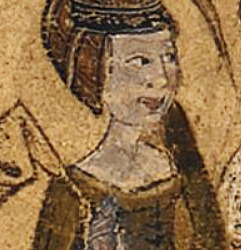
Isabel of Castile, First Duchess of York
Isabel was the third of four children of King Pedro I, also known as Pedro the Cruel, who ruled the Crown of Castile from 1350. Her mother was the vivacious and intelligent Maria de Padilla, often described as Pedro's mistress. In 1361, when Isabel was only six, her mother died. The following year, Pedro declared that he and Maria had been lawfully married before he was forced to espouse his estranged French wife, Blanche of Bourbon, who was by then also dead, some said murdered by her husband. His claim of an earlier marriage was subsequently endorsed by the Cortes, thus legitimising Pedro's children by Maria. Pedro was killed by his illegitimate half-brother and deadly enemy Enrique of Trastámara in March 1369. Trastámara became King Enrique II of Castile.
Isabel accompanied her elder sister Constanza to England, and married Edmund of Langley, son of Edward III and Philippa of Hainault, in 1472 at Wallingford, as part of a dynastic alliance in furtherance of the Plantagenet claim to the crown of Castile. Isabel was only 16 or 17 to Edmund’s 31, and brought him no lands or income or even the promise of such because her sister Constanza – who married Edmund’s elder brother John of Gaunt as his second wife – was their father’s heir. John and Constanza spent many years trying unsuccessfully to claim her late father’s throne from her illegitimate half-uncle Enrique of Trastamara, while Edmund and Isabel were required to give up any claims to the kingdom of Castile and were not compensated.
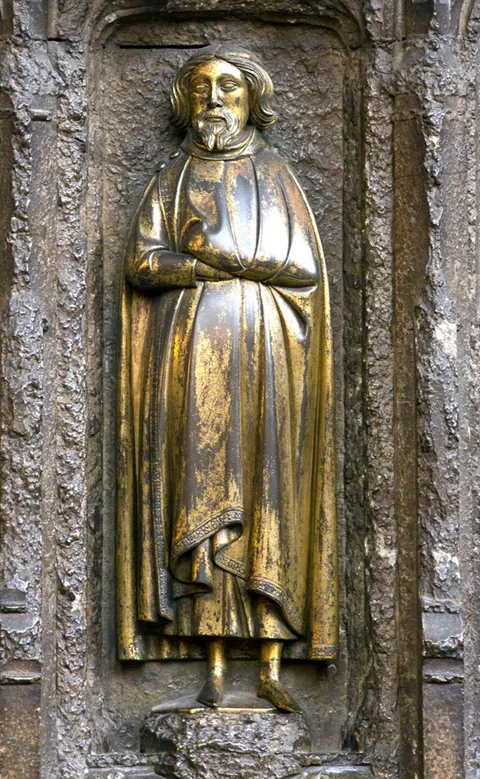
As a result of her marriage, Isabel became the first of a total of eleven women who became Duchess of York. She was appointed a Lady of the Garter in 1379. In their twenty years of marriage, the Duke and Duchess of York had three children:
Edward of Norwich, Duke of York
Constance
Richard of Conisburgh, Earl of Cambridge
Contemporary sources suggest that Edmund and Isabel were an ill-matched pair and their relationship was a rocky one, with Isabel accused of having an affair with John Holland, Duke of Exeter and half-brother to Richard II. The affair is believed to have started as early as 1374 and likely continued for a decade. As a result of her indiscretions, Isabel left behind a tarnished reputation. The chronicler Thomas Walsingham considered her to have somewhat loose morals.
John Holland has also been suggested as the real father of Isabel’s youngest son, Richard of Conisburgh, who was the grandfather of Edward IV and Richard III. The fact that his father Edmund of Langley and brother Edward, both, left him out of their wills has fuelled this theory. However, leaving a son out of your will was not entirely unusual, and Richard had died when his brother made his will.

Isabel of Castile died in December 1392 at the age of about 37 and was buried at Langley Priory in Hertfordshire. In her will, Isabel left items and gifts of money to close relatives by blood or marriage, and to numerous servants of hers, men and women. Isabel referred to Edmund of Langley as her "very honoured lord and husband of York", and left him all her horses, all her beds including the cushions, bedspreads, canopies and everything else that went with them, her best brooch, her best gold cup, and her "large primer". Isabel named King Richard II as her heir, requesting him to grant her younger son, Richard, an annuity of 500 marks. Isabel left nothing at all to her older sister Constanza, duchess of Lancaster, and failed even to mention her. Isabel doesn't forget John Holland in her will, at this time married to Elizabeth of Lancaster, John of Gaunt's daughter.
About 11 months later her widower married Joan Holland, niece of Isabel's supposed lover, John Holland. In another bizarre family twist, it was Joan’s brother, Edmund Holland, Earl of Kent, who had an affair – and an illegitimate daughter – with Constance of York, the daughter of Edmund and Isabel. In Edmund’s own will of 1400 he requested burial ‘near my beloved Isabele, formerly my consort.’ Despite Isabel of Castile's bad reputation and supposedly having been involved in a court scandal that humiliated her husband, Edmund seems to have felt great affection for her as demonstrated by his willingness to rest eternally with Isabel and not with his second wife.
Source:
#Isabel of Castile#Edmund of Langley#Duchess of York#Duke of York#women in history#english history#spanish history
13 notes
·
View notes
Note
I’m currently listening to Anne Boleyn: 500 Years of Lies by Hayley Nolan on Audible, and I’m trying hard to like it because it has really good information discrediting some of the beliefs surrounding Anne; but I have to admit that it’s grating me to hear the author stating that the Tudors were “usurpers” and that they were preventing a “more rightful heir” from gaining the throne. I almost screamed in frustration when she blamed H8’s sociopathy on Margaret Beaufort and especially Henry VII, using that one source claiming that H7 once tried to kill H8 in a fit of rage as firm evidence of a miserable childhood (ignoring all evidence stating otherwise); because of course having an overprotective parent (which is all H7 was) is going to cause you to grow up with no conscience. Also is it true that H8 was given absolutely no training in monarchy and came to the throne completely uneducated in that regard, I find that incredibly hard to believe regarding H7.
Hello! First of all, there's so much to unpack here. I think we have to go step by step. A big disclaimer is that I have not read Nolan’s book, so I’m only considering what you told me here. Secondly, I will not be addressing any claims against Margaret Beaufort because, frankly, what did that woman ever do be accused of that — the same Margaret Beaufort who 'of marvayllous gentyleness she was unto all folks' , and who 'unkind she would be unto no creature'? Are we talking about the same Margaret? We know one of her old servants, Henry Parker, was talking about his 'godly mistress the Lady Margaret’ to her great-granddaughter Mary well into the mid-1500s, and we know the time Margaret reprimanded a dean in Christ's College for beating one of his pupils (crying ‘gently, gently!’). I don’t see how she could be considered the origin of anyone’s sociopathy, but I also dislike the term — antisocial personality disorder is a medical condition and I doubt we could ever diagnose Henry VIII with that or anyone else who died five hundred years ago for that matter. The rest of my answer is under the cut!
Well, now for the rest: I wouldn't say all of the Tudors were usurpers. Henry VII very much was one, as he did unseat England's king at the time of his invasion though that hardly makes him worse than other 15th-century English kings (as I've talked here, Henry IV was a usurper, Edward IV was a usurper, Richard III was a usurper — hell, William the Conqueror had been a usurper four centuries earlier). None of Henry VII's successors would have been usurpers, though (unless we should say every English king after William the Conqueror was a usurper, I guess?). Especially if you consider that they were also the natural successors of the Yorkist line via their descent from Edward IV's eldest daughter and heir, Elizabeth of York. I have no idea who Nolan could be referring to as the 'more rightful heir': the de la Poles, the descendants of Edward IV's sister? The Poles, the descendants of Edward IV's brother? Even if you go by Yorkist descent alone (which not everyone in England regarded as the most legitimate), who would have had a better claim in England than Henry VIII, the son of Edward IV's surviving heir and the son of England's most recent conqueror, Henry VII?
As for Henry VIII's miserable childhood, I don’t think there is evidence of that. We know Henry was well-educated; his father made sure to appoint tutors who taught him in the arts, classics, music, dancing, discourse, courtiership and theological disputation. We also know that Henry VII was personally involved with his sons' education, whilst his wife Elizabeth was involved with their daughters'. It is true that Henry VIII was not initially prepared for kingship but once his brother Arthur had died his father began preparing him for his future office. In July 1504 Prince Henry officially moved into his father's household where it seems Henry VII tutored him personally in some subjects. In August of that same year, the Duke of Estrada, a Spanish ambassador, wrote that 'Formerly the King did not like to take the Prince of Wales with him, in order not to interrupt his studies [...] But it is not only from love that the King takes the Prince with him; he wishes to improve him. Certainly there could be no better school in the world than the society of such a father as Henry VII. He is so wise and so attentive to everything; nothing escapes his attention'. So you can see that Henry VIII was assisted and had at least five years to prepare for the office of kingship, which is more than Henry VII himself ever had.
Lastly, it's clear that Henry VII loved his son. The same ambassador, Duke Estrada, also said in his dispatch: 'It is quite wonderful how much the King likes the Prince of Wales'. There are several entries in Henry VII's privy purse accounts describing items and stuff he bought to his younger son, always referring to him as 'My Lord Harry'. For all we know, Henry VII saw much more of his second son than he ever saw of Prince Arthur who lived in Ludlow, away from court. There is that anecdote about the time Henry VII knighted Prince Henry when he was only three years old: during the ceremony the king picked up his young son and placed him on a table for all to see — a gesture possibly made out of love, fondness, and/or delight in his youngest, though we can only speculate. Henry VII seems to have been determined not to expose his remaining son to danger in the same way that Arthur had been, and some of his more overprotective measures (like the setting of the Prince's apartments, accessible only by way of his own) can be understood as born out of paternal concern, all things considered. The rumours that the Calais garrison was not willing to crown Prince Henry in the event of his death were certainly of great concern to Henry VII.
To sum up, there is evidence that Henry VII did love and care for his son Henry. No doubt their relationship may have been strained at times thanks to Henry VII’s overprotective measures, but it’s also true the king let his son shine on many occasions in his place, denoting both affection and trust. Henry Pole's claim, made in 1538, that the king ‘had no affection nor fancy unto’ his heir should be seen in its proper context: one in which his brother, Reginal Pole, was involved in an ideological campaign against Henry VIII — the message was that not even Henry VIII's own father had loved him. I cannot say if Henry Pole actually said those words (anyone with more expertise please feel free to correct me) or if those were brought up as charges against him, but they do belong in the realm of (real or invented) seditious language. I tried to find the claim that Henry VII once tried to kill his son over a fit of rage in the dispatches sent by Fuensalida (allegedly the one who made that claim according to Hutchinson’s Young Henry), but the only thing I could find was something akin to court gossip, saying Henry VII treated everyone badly for a time (including his son) and spent three hours every night with his eyes closed but not sleeping...... which is??
(Here I should comment that Fuensalida not only disliked Henry VII but he was also several times denied access to the king and the Prince of Wales on account of what the English most likely considered to be his rude behaviour. He is also the one who said the Prince was kept closeted away like a girl, not realising that he was specifically denied access to the Prince — perhaps not without reason, seeing how Ferdinand had instructed him in winning the Prince over to their cause. Fuensalida was, of course, only serving the interests of his king, but his skills in diplomacy are somewhat unusual. Even Catherine of Aragon would later complain about Fuensalida’s behaviour).
In any case, I cannot speak about Nolan’s book as I have not read it but I wouldn’t be surprised if the author makes some unsubstantiated claims, considering the book was not peer-reviewed. That’s exactly how many pop history books work and why it’s hard to hold them to high standards. I hope this answer is not a big rambling mess, but really there were so many things to address, I didn’t even know where to begin. Thanks for the ask, anon! 🌹x
88 notes
·
View notes
Text
Every rebellions, plots, conspiracies, and seditions against Henry VII, by chronological order.
1485: Henry VII becomes king after his victory at Bosworth. Two hundred men from the Calais garrison flee to Flanders.
1486: attempted murder against Henry VII at York. The Stafford brothers rebel and take Worcester, while viscount Lovell rebels in Richmondshire. Eventually, the Stafford brothers are captured and one executed, while Lovell flees in Flanders to the court of Margaret of York, dowager duchess of Burgundy.
1487: Lambert Simmel's rebellion. A Yorkist conspiracy proclaims a commoner Lambert Simmel to be the escaped earl of Warwick from the Tower (Edward Plantagenet, nephew of Richard III and Edward IV). He is proclaimed 'Edward V' in Dublin by the Anglo-Irish aristocracy and joined by 2,000 german mercenaries led by viscount Lovell and his cousin John de la Pole, Earl of Lincoln. With a mixed german-irish force, Landing in Lancashire enjoyed limited defection in northern England (mainly lord Bolton of Scrope, lord Bolton of Masham, and Sir Thomas Broughton). Their ~8,000 force is beaten at Stoke by a Tudor army led by the king and the earl of Oxford. Death of Lincoln and Lovell, Simmel is spared. Before the rebellion, Henry VII preemptively jails some key Yorkists, including his mother-in-law Elizabeth Woodville and his brother-in-law the Marquess of Dorset.
1489: Anti-tax rebellion in Yorkshire. The rebels led by Sir John Egremont murder the earl of Northumberland and take York before dissolving at the arrival of the royal army. Egremont flees to the court of Margaret of York.
1491: At Cork, a man proclaims that he is Richard of Shrewsbury, the disappeared second son of Edward IV. His true identity remains unknown. ‘Richard’ receives immediate support nonetheless from some Yorkists such as John Taylor, a former supporter of the duke of Clarence (Edward IV's brother).
1492: 'Richard' land in France, where he was welcomed by Charles VIII, who is at war with England. Henry VII retaliate by an invasion from Calais and sign the treaty of Etaples. Charles VIII agreed to stop supporting English rebels and give the Tudor king a pension.
1492: The peace treaty is unpopular in England, and 'Richard' is welcomed in Flanders by Margaret of York and Maximilian of Habsburg, ruler of the Burgundian estates. Maximilian is angered by the separate peace Henry VII made without consulting him. He recognizes him as the rightful king of England. The news of Richard's survival and reappearance began to be known in England and test the allegiance of Henry VII's subjects.
1493: Henry VII retaliate by imposing a blockade on the Netherlands. Counter-measures ensued, leading to an embargo from both parties, which lead to riots in London. 'Richard' assists at Maximilian's coronation as Holy Roman emperor and is promised support for his restoration. Scotland and Denmark recognize his legitimacy.
1494: Maurice Fitzgerald, earl of Desmond, revolts against the Tudors and leads a rebellion in Munster.
1495: an essential group of plotters is arrested. It consists of the king's own Chamberlain and the most powerful knight in England, Sir William Stanley (he was mighty in Cheshire and had £10,000 of reserve in cash at his castle of Holt). Lord Fitzwater (important Calais official and landowner in East-Anglia), Sir Simon Mountford (significant landowner in Warwickshire), William D'Aubeney, Thomas Cressener, Thomas Astwode, and Robert Ratcliff. They were mainly former supporters of Edward IV, and some had connections with duchess Cecily's household. Sir Robert Clifford, one of the plotters, betrayed the entire plot and was pardoned. Others were fined or executed, like Stanley.
'Richard' prepares to invade England by East-Anglia with a force of exiled and Flemish mercenaries. Stormy winds scattered his forces and made him land in Kent, and his force of 300 soldiers is beaten by the Earl of Oxford at his arrival at Deal. He flees and lands with the remainder of his troops in Ireland, where the revolted earl of Desmond joins him. Their combined forces fail to take Waterford. After this defeat, 'Richard' and his supporters arrive in Scotland.
1496: restoration of trade between The Netherlands and England, as Henry VII join the Holy League against France. The earl of Desmond also makes his peace with Henry VII. A Scottish army invades England as 'Richard' promised to give Berwick £50,000 to the Scottish king James IV. Little result ensues except for some small raidings.
1497: 'Richard' marries a cousin of the Scottish king, Catherine Gordon. As the king of Scotland makes a truce with England, he tries to land once again in Ireland with Sir James Ormond's support. However, Ormond's murder led to the failure of the uprising, and 'Richard' flee from Ireland with three ships.
Taxation for the Scottish war led to the Cornish rising. A blacksmith, Michael Joseph, leads the revolt with lord Audley and brings many gentrymen from Cornwall to rebellion. The rebellion extends to neighboring counties as the rebel take Exeter and march to London, virtually unopposed. A 25,000 royal army face some ~15,000 rebels at Blackheath, near London, and triumph. Once again, the earl of Oxford's vanguard is instrumental for the victory against the rebel.
'Richard' finally land in Cornwall, hoping to bolster his support with the Cornish's discontent. An uprising in his favor occurs (second Cornish rebellion), and his 8,000 men fail to take Exeter. His attempted fleeing after the encirclement of his forces by the Tudors led to his capture at Bealieu abbey.
'Richard' confess he is an impostor and a Flemish by the name of Perkin Warbeck. He and his wife are welcomed at court.
1498: 'Richard' tries to escape court and is captured and jailed in the Tower of London.
1499: A Cambridge scholar by the name of Ralph Wiford dreamt that he would become king if he claimed he was the earl of Warwick. His uprising in East Anglia failed, and he is executed.
Edmund de la Pole, earl of Suffolk and brother of the Earl of Lincoln (thus nephew of Richard III), leave England for Flanders after killing a commoner in London before agreeing to come back.
The French hand over many supporters of 'Richard' in France, including John Taylor. Many are executed, but Taylor's life is spared.
An attempted escape made by 'Richard' and his cousin Edward, earl of Warwick, fail, and they are both executed.
1500-1503: Henry VII lost his wife in childbirth and two sons (Arthur and Edmund). Dynastic fragility ensue as Henry VII have only one surviving male heir.
1501: Edmond de la Pole and his brother Richard flee for the Flanders. Henry VII promptly jail their brother, William, with Sir James Tyrell and Lor William Courtenay. Royal officials are sent in East Anglia to monitor the de la Pole affinity. Sir James Tyrell 'confess' before his death the murder of the Princes in the Tower for Richard III.
1504: 'treasonous' talks between Calais officials. They argue about who would be the successor for a declining Henry VII and hesitate between the duke of Buckingham and the Earl of Suffolk, omitting Henry VII's children.
1506: The Habsburgs deliver Edmund de la Pole to Henry VII, who jail him at the Tower of London. In exchange, Henry VII loan them immense sums of cash, such as £108,000 in April.
1509: Henry VII dies, leaving the crown to his adult heir, Henry VIII.
I might have missed some small, aborted plot, but there it is.
With this chronology, it's evident that the War of the Roses (or, more accurately, the war of the succession crisis of 1483) didn't end at Bosworth. Henry VII could have been overthrown in 1487 or the late 1490s. There is also a clear distinction between the rebellions of the 1480s and those of the 1490s. The plot following HenryVII's advent is mainly coming from RichardIII's basis of power. It's his men (Lincoln, Lovell, many northerners), his bases of support (the North and Ireland) who try to overthrow the first Tudor.
The plots of ''Perkin Warbeck'' known in historiography, were perilous for Henry VII. Most of his dynastical legitimacy comes from his marriage to Elizabeth of York. A true surviving son of Edward IV would nullify this and put into question the support of every former servant of the late Yorkist king. Hence, Henry VII tried to depict 'Richard' as an impostor and to demonstrate that the Princes of the Tower were dead. Still, he couldn't convince everyone and had to resort to force and the systematic use of a spy network.
Some of those plots might have been exaggerated. The 1504 Calais plot was undoubtedly not a carefully crafted conspiracy but more a manifestation of Henry VII's difficult succession. This chronology also doesn't show the dubious role that many magnates had during this period of unrest. The loyalty of Lord Abergavenny (dominant in Kent) was put into question, as was one of the earls of Derby in the 1490s and Lord Daubeney. Henry VII didn't have many magnates on whom he could truly count.
As you can see, Henry VII was never wholly free from dynastic uncertainty. At his death, Richard de la Pole was still free to push his claim if his brother Edmund died. Henry VIII himself was very wary of potential claimants toppling him. His execution of Edmund de la Pole in 1513 and the duke of Buckingham in 1521 are the best manifestations of this insecurity.
#henry vii of england#war of the roses#tudor era#Perkin Warbeck is named 'Richard'#we don't have definite proof of his identity#richard iii
68 notes
·
View notes
Text
Court Archetypes: The Pretender

There are always those who want the throne. They carve it, they need the power it gives... or else somebody behind them wants them to do it. Pretenders add a threat to any throne as well as interesting subplots for your WIP.
The Successful
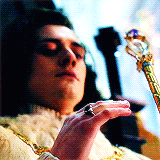
These were all pretenders in their times but they won their throne and kept it for a number of years.
Stephen I of England: Henry I had one son and a daughter. His son died in a shipwreck, leaving his daughter, Matilda or Maud to take the throne on his death. During this period, England's empire straddled the Channel. Matilda was in France when her father died and pregnant as well. In her absence, her cousin Stephen seized the throne. So ensued a bloody war for the throne which Matilda was winning at one point, entering her coronation but was chased away by Londoners. Matilda gave up the war on the terms that her son Henry would become King when Stephen died, which he did.
Richard III: I like Richard. He suffered from scoliosis, remained loyal to his brother and had a fairytale-like elopement with his wife. In 1483, Richard's brother died leaving a twelve year old heir. Richard had agreed to act as Regent but after putting off the prince's coronation for months, arresting the boys maternal uncle and half brother, executing his dead brother's best friend and imprisoning his brother in the tower with him, Richard seized the throne. There is murkiness about whether Richard had the boys killed. The boys did vanish but whether it was Richard or another power, we can never know for certain. Personally, I think Richard was acting in protection for the realm which would have been endanger from civil unrest, the commons resented the Queen's family and there were other pretenders. Richard was a tested battle commander and the strongest hope to keep the country stable. I think he had good intentions if he went the wrong way about it.
Edward IV: Edward was the son of another pretender, Richard of York. When Richard of York died at the hands of Margaret of Anjou along with his young son Edmund, Edward took up the mantle of kingship and ousted the House of Lancaster from the throne, installing the House of York.
The Exiles

Some royals were thrown out of their homeland by either a coup or another pretender. Sometimes they're the hero, other times they are not.
Charles Edward Stuart ("Bonnie Prince Charlie): I have mixed feelings about this man. He doesn't deserve the grand legend attached to him nor the kindness history gilds him with. He was a drunken fool who led thousands to their death like his shithead father. But his claim is just. The only reason barring him from his throne is his religion. His story should have been a fairytale, the prince riding to reclaim his family throne. But he died a poor beggar, drinking and lamenting past glories.
Charles II: Charles II was exiled from England along with his mother and younger siblings after the monarchy was overthrown. Charles was technically a pretender while Oliver "Dickbreath" Cromwell ruled England. He shot his shot when Cromwell died and restored the monarchy.
Henry VII: Henry had no chance at throne. Born of a legitimized bastard line and a Welsh line, Henry was not the first person people thought of when considering heirs to the throne. During the mess of the Wars of the Roses, he got closer and closer to the throne which meant he was a threat to the Yorkist line. He escaped to Brittany and then to France, where he waited for his chance. His mother helped orchestrate his two invasions of England, his second being successful at Bosworth Field.
The False
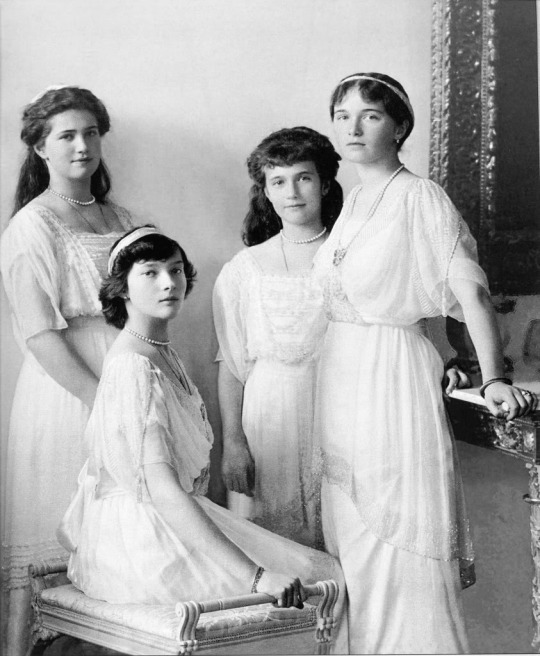
Some Pretenders are not pretenders at all. Some Pretenders are charlatans or mad men or perhaps greedy fools. Some are even almost successful
Perkin Warbeck (Richard Plantagenet/ Richard IV?): Perkin Warbeck, the son of a Tournai boatman, invaded England in 1495 under the guise of Prince Richard Plantagenet, Prince no. 2 in the Tower. He went to Scotland to garner support, winning a wife from the Scottish King. He rode south toward London, the country divided in opinion over his legitimacy. Was he the lost Prince of York? Real or not, Warbeck was defeated. Henry VII chose to be merciful offering Warbeck a place a court which he accepted. But the plots kept swirling about the mysterious pretender. In order to secure an alliance with Spain, Henry was finally forced to kill the pretender. Was he really Prince Richard? Some historians say no, some say yes. As for me, I am open to the theory that he is but I rather liked to think that if Prince Richard did survive the Tower, that he found safety somewhere far away and forgot all about crowns and thrones. Of course, that's just wishful thinking....
Anna Andersen (Anastasia Romanov): In 1918, the Russian Tsar, Tsarina, Tsarevitch and four Grand Duchesses were executed by rebels. Once that terrible murder happened, rumours began to spread that one daughter had escaped when they were burying the bodies, helped away by a young scared soldier. The rumours allowed pretenders to come forward pretending to be the youngest daughter, Anastasia. The remaining Russian royals met with several promising ones but they all cons. In Germany in the 1920s, a young woman began claiming to be the Grand Duchess. A few members of the royal family met her and believed her along with her childhood friend, Gleb Botkin. There was some evidence, her signature was the same, she knew somethings about the Grand Duchess's childhood and had similar birth marks. By the time DNA testing came about, Anderson was dead. They tested her remains and it was clear that she was a pretender. I don't like Andersen but I think that she did believe in the lie, she was emotionally disturbed person with a history of mental illness.
Yemelyan Pugachev (Peter III of Russia): Pugachev was a Cossack who led a rebellion against Catherine the Great. He convinced a great number of Russian serfs that he was the dickweed Peter III, who had died months after his wife Catherine kicked him off the throne. She may or may not have known about the assassination plot against his life. Catherine's armies obliterated the rebellion and Pugachev was beheaded, drawn and quartered.
The Puppet

Some Pretenders are just innocents who troublemakers gather about in order to gain power. The puppet pretender is always a sympathetic figure in literature.
Edward Plantagenet, Earl of Warwick: Edward was a simple-minded child whose great misfortune it was to be born into the House of York. The son of the Duke of Clarence, the brother to two of England's kings, he was named heir to the throne by his uncle Richard III when his own son died. Edward was imprisoned in the Tower when Henry VII came to power. But though Edward was likely incapable of ruling, Yorkist rebels kept rebelling in his name. In 1499, he was executed at the behest of the Anglo-Spanish treaty. He was a harmless man killed for a throne he likely didn't even realise was his by right. It is probably the one of the only events of history that I hate.
Lambert Simnel: Lambert Simnel was a pretender to the throne during the reign of Henry VII. He was a schoolboy who was placed at the head of a Yorkist rebellion for the resemblance between he and the Princes in the Tower. He was put forward as the Earl of Warwick, who people believed had escaped the Tower. When the rebellion was quashed, Henry VII was merciful and had the boy placed in the kitchens as a spit boy. Years later, he went on to become a royal falconer. Nothing else is known about his life.
Lady Jane Grey, Queen of England: Jane Grey was named Queen by her predecessor and cousin Edward VI. This was mainly due to her being Protestant as Edward VI was a Reformer. Jane had not wanted to be Queen, claiming that it was her Catholic cousin's throne not hers. In the name of faith, she was pressed to proclaim herself queen, in which the heralds had to explain who she was and how she could be queen. People had trouble with the claim for a few reasons: the succession had never included her only the king's two sisters, her mother who she drew her claim through was still alive meaning her mother was ahead of her by rights and nobody knew who she was. Jane's ascension had been a grand plot hatched by the Dukes of Suffolk and Northumberland. Northumberland wed Jane to his own son only months before. But Jane was no shrinking violet. In her nine days, she told her husband that he would never be king only a duke, she wrote her declarations signing herself as queen and ordered Northumberland to head her armies in place of her father. When Mary I ousted her from the throne, Jane was glad to give up the throne but not her Protestant faith. After failed rebellions to put Jane back in power, Mary I had no choice but to have her executed.
#court archetypes#Pretenders#Richard iii#stephen I#Anastasia romanov#lambert simnel#lady Jane Grey#writing advice writing resources#writer problems#writing resources writing reference#writing reference#writing resources#writing advice#fantasy#fantasy nobility#fantasy guide#writing guide#characters#fantasy characters#fantasy courts#history dump#archetypes#fantasy archetypes
763 notes
·
View notes
Note
OK. I've got to ask--Henry VI? I think you're the first person I've met who claims those as their favorite Shakespeare. I'll admit that I've read and seen a fair bit of Shakespeare, but I'm not familiar with them at all. What's the appeal? Why do you love them? Sell them to me. ;)
Oh boy, here we go :))))) (Thank you for giving me permission to scream - I also think I’m the only person I’ve ever met who has those as their favorite Shakespeare plays). Also, as we’ve talked opera - I think these plays could make a great Wagnerian style opera cycle.
First off, little disclaimer: I’m not a medievalist, so I can’t say that I’ve definitely got the best interpretation of the Wars of the Roses and the history that the H6 cycle covers. I know I do not - so you may read these plays and have totally different interpretations, and that’s great! This will kind of be how I came to love the plays and why they were (and still are) exciting for me to read.
I will admit, these plays are a bit of a minefield (as my Shakespeare professor said during a lecture on the histories and I don’t think I’ll ever forget that descriptor). Some of these scenes are not as well written, and many of them are almost irrelevant to telling a tight-knit story, so things get cut. Sometimes 1H6 is just cut entirely from productions, and I might venture to say that it is probably the least performed Shakespeare play. We get lines like “O, were mine eyeballs into bullets turn’d, / That I in a rage might shoot them at your faces” (1H6.4.4.79-80), which I might say is nearly on par with “a little touch of Harry in the night” from Henry V. But despite the unevenness, there is so much from these plays that are meaningful, heartbreaking, and that continue to fascinate me. There’s so much about power and leadership that we can learn from these plays - and perhaps that’s why I took an interest in 1990s British politics because there are actually some very interesting similarities happening - but also a lot we can learn about empathy, hope, and love.
These plays have a lot of fascinating key players - it would honestly be a privilege to play any of them - and most (if not all) of these key players have some claim to power, just in the family lines they were born into. And this conflict is one that’s been building up since Richard II. With the Wars of the Roses we have a man who is unwilling, and sometimes unable to lead because of various circumstances, some of which having to do with his mental health, which was generally poor, and some of which have to do with the various times he was dethroned, captured, etc. - and I say unable for lack of a better word. Essentially, politics in these plays are caving in, and at a very rapid pace. There’s a hole at the center of government and people are ambitious to fill it. We also have a lot of people who could potentially fill that role, people who on principle, have a lot of political enemies. The nobles in these plays are having to assure that they themselves are in power or that their ally is in power, otherwise it is their livelihood at stake.
We have Henry VI, who was made king at nine months old after the untimely death of his father, the famous Henry V, and basically has people swarming him since birth claiming that they’re working in his best interest. He’s a bit of a self-preservationist to start, but by the end we see a man completely transformed by the horrors of war and ruthless politics. I also think he might be the only Shakespeare character who gets his entire life played out on stage. We see him at every stage of his life, which makes his descent all the more bitter. (One cannot help but see the broken man he is at forty-nine and be forced to remember the spritely, kind boy he was at ten). He’s a man who clings closely to God in an environment where God seems to be absent. He desires peace, if nothing else, and he wants to achieve this by talking things through. He’s an excellent orator (one only needs to look at the “Ay Margaret; my heart is drown’d with grief” monologue from 2H6, but there are countless other examples), but there’s a point where even he realizes that his talking will achieve nothing, and his alternative is heartbreaking.
We have his wife, Queen Margaret, otherwise known as Margaret of Anjou, or the “she-wolf of France”. I advertise her as “if you like Lady Macbeth, you’ll love Margaret of Anjou”. Sometimes Shakespeare can portray her as wanting power for herself, but I genuinely think she wanted a good life for her husband and her child, otherwise the alternative is begging at her uncle’s feet for protection in France (her uncle was Charles VII of France) while separated from her husband, having her or a member of her immediate family be killed, or worse. I think it’s important to remember with Margaret that historically she came from a family where women took power if their husbands were unable to. Her assumption of power in these plays is something that’s natural to her, even if it’s not reflected very well in Shakespeare’s language. You also see some fantastically thrilling monologues from Margaret as well, especially her molehill speech (one of two molehill speeches in 3H6, totally different in nature - the other one is from a heartbroken and forlorn Henry after the Battle of Towton) - Margaret’s monologue has got the energy of a hungry cat holding a mouse by the tail.
Also Henry and Margaret have a fascinating relationship. Because they’re so different in how they resolve conflicts, they grow somewhat disenchanted with each other at times, and can actually be mean to one another, despite their love. My favorite scene might be at the start of 3H6, where Margaret has come in with their seven year old son, Edward, and starts berating Henry for giving the line of succession to the Yorkists. What strikes me there is that we have a little boy having to choose between staying with his mom, or going with his dad - it’s something very domestic, and I think the emotional accessibility of that scene is what makes it memorable. It’s not about politics for me at that moment, it’s about a boy having to choose between his very estranged parents. Here’s a little taste from 1.1. in 3H6 - lines 255-261:
QUEEN MARGARET: Come son, let’s away. / Our army is ready; come, we’ll after them.
KING HENRY: Stay, gentle Margaret, and hear me speak.
QUEEN MARGARET: Thou hast spoke too much already. Get thee gone.
KING HENRY: Gentle son Edward, thou wilt stay with me?
QUEEN MARGARET: Ay, to be murdered by his enemies.
We also have Richard, Duke of York, who is Henry’s cousin and leader of the Yorkist faction. If you’re at all familiar with 1990s British politics, as I have grown close to over the past month, York reminds me very much of Michael Heseltine (filthy rich and constantly vying for power) - and I would love to stage some kind of modern H6 cycle production just so I could make that connection. York’s father is one of the three traitors executed by Henry V at the start of H5, leaving him an orphan at four years old (historically). He is also Aumerle’s (from R2) nephew, and so when Aumerle dies at the Battle of Agincourt, little four year old Richard inherits both his father’s money and titles, and his uncle’s money and titles, making him the second richest nobleman in England behind the King. All this information is historical and doesn’t really show up in the play, but I think that kind of background would give a man some entitlement. He’s also next in line for the throne if something were to happen to Henry (until Henry has a son), so he feels it is his duty as heir to the throne to protect Henry (or in better words, he feels that he should be running the show) - Margaret feels that it is her duty to protect Henry as she is his wife and mother of Edward of Westminster, the Lancastrian heir, and so you can see where these two are going to disagree.
More fascinating are York’s sons, Edward, George, and Richard. Edward is this (for lack of better words) “hip” eighteen year old who comes and shreds things up at the Battle of Towton - becoming Edward IV in the process and chasing Henry off the throne. He is incredibly problematic, but I might venture to say that he’s the least problematic of the trio of York brothers. George of Clarence is (also for lack of better words) “a hot mess” and feels entitled to power, even though he may not readily give his motivations for it. I think he just wants it, and so he actually ends up switching sides mid-3H6 because he would actually be in a better position in government with those new allies. And finally, we have Richard of Gloucester (future Richard III), and in 3H6, you just get to see him sparkle. It puzzles me a bit how people can just jump into Richard III without getting any of the lead up that Shakespeare gave in the H6 cycle, and I think 3H6 is the perfect play to see that. I think it clears up a lot of his motivation, which Shakespeare didn’t get perfectly either, because there are some ableist things going on with these plays. He’s just as bloodthirsty, just as cynical, but in this play, he wins out the day.
These are just a few of the main characters. We’ve also got Richard Neville, Earl of Warwick (known to history as “The Kingmaker”), who is this incredibly powerful nobleman who is wicked skilled in battle and seems to have a lot of luck in that area (until he doesn’t). We’ve got Clifford, who is just as bloodthirsty as Richard III (if not more so). We’ve also got Humphrey, Duke of Gloucester - Henry’s uncle and quite unpopular with his fellow noblemen, and Eleanor Cobham, his wife who gets caught in the act of witchcraft. (Talk to my lovely friend @nuingiliath if you want to hear about Humphrey or Eleanor). Joan of Arc also makes an appearance in 1H6, and often she’s the only reason that 1H6 gets performed.
There are so many ways to latch onto this cycle, and it can be for the huge arcs that these characters go on, or it can be for the very small reasons, like in the first scene of 3H6, like I mentioned earlier. It’s very much akin to Titus Andronicus in the language (I did a bit of research a while ago about the use of animal-focused language in Shakespeare’s plays, and the H6 cycle and Titus Andronicus lead the charts just in terms of frequency of people being referred to metaphorically as animals- they’re also chronological neighbors, all written very early in Shakespeare’s career). Also, these plays held a huge amount of weight at the time they were written - the effects of the Wars of the Roses were still pressing over the political climate of the 1590s.
I think these plays are great to read just in being able to contextualize the histories as a whole - you get to know how things fared after Henry V (spoiler: not well), and you also get the lead up to Richard III. The ghosts in Richard’s dream make sense after reading the H6 cycle - because those ghosts lived in the H6 cycle, and (spoiler: Richard wronged them in the H6 cycle). They were also the first of Shakespeare’s history plays, so you read subsequent histories plays that make subtle references to the H6 cycle, and I think you can take so much more out of the rest of the histories plays once you’ve read these.
I hope this was a little informative, and perhaps persuaded you to check them out!
Productions I recommend (you can click on the bold titles and it’ll take you to where you can access these productions):
Shakespeare’s Globe at Barnet (2013) // Graham Butler (Henry VI), Mary Doherty (Margaret of Anjou), Brendan O’Hea (Richard, Duke of York), Simon Harrison (Richard of Gloucester) - filmed at Barnet, location of the Battle of Barnet, where Warwick was killed in 1471.
ESC Production (1990) // Paul Brennen (Henry VI), June Watson (Margaret of Anjou), Barry Stanton (Richard, Duke of York), Andrew Jarvis (Richard of Gloucester) - a more modern production, one cast put together all seven major Plantagenet history plays (1H6 and 2H6 are combined into one play - a normal practice). Sometimes this footage can be a bit fuzzy, but I loved this production.
The Hollow Crown Season 2 // Tom Sturridge (Henry VI), Sophie Okonedo (Margaret of Anjou), Adrian Dunbar (Richard, Duke of York), Benedict Cumberbatch (Richard of Gloucester) - done in a film-like style, also with some pretty big name actors as you can see. Season 1 stars Ben Whishaw as Richard II, Jeremy Irons as Henry IV, Simon Russell Beale as Falstaff, and Tom Hiddleston as Hal/Henry V. (also available on iTunes)
RSC Wars of the Roses (1965) // David Warner (Henry VI), Peggy Ashcroft (Margaret of Anjou), Donald Sinden (Richard, Duke of York), Ian Holm (Richard of Gloucester) - black and white film, done in parts on YouTube.
BBC Henry VI Plays (1983) // Peter Benson (Henry VI), Julia Foster (Margaret of Anjou), Bernard Hill (Richard, Duke of York), Ron Cook (Richard of Gloucester) - features my favorite filmed performance of Edward IV (played by Brian Protheroe), and my favorite filmed performance of Warwick (played by Mark Wing-Davey).
Also if you ever get to see Rosa Joshi’s production of an all female H6 cycle... *like every time I see photos my immediate reaction is *heart eyes* I haven’t seen it yet, but my amazing friend and fellow Shakespearean @princess-of-france has - I’m sure she’d love to talk more about it sometime! I’ll leave a picture I found on the internet...

Also tagging @suits-of-woe because we could cry about these plays all day.
#thank you for this!#i'm not putting it under a cut because my tumblr has been weird with that function lately#so instead i will tag it#long post#henry vi#h6 cycle#shakespeare#shakespeare's histories#the histories#1H6#2H6#3H6#also friends add on!#we have a neat little histories fandom on here#add the reasons h6 is a lovely thing and should be advertised more#i'd love to hear your thoughts#this is very general#i love the character of henry vi in particular#but all of them are fascinating#also there's a point in 2H6 where henry is so overcome with shock and grief that he just faints#like same but poor bby#that's my favorite moment in the whole cycle actually#there's some switch that goes off in him after that#i just love these plays ahhh#theatre#shakespeare discussion#the wars of the roses#vera-dauriac
41 notes
·
View notes
Photo
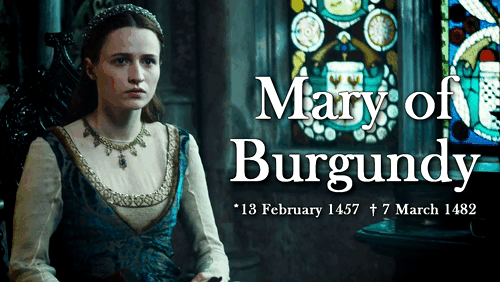



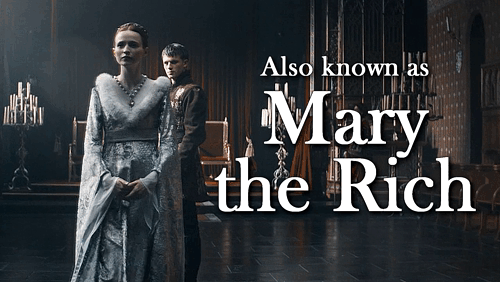

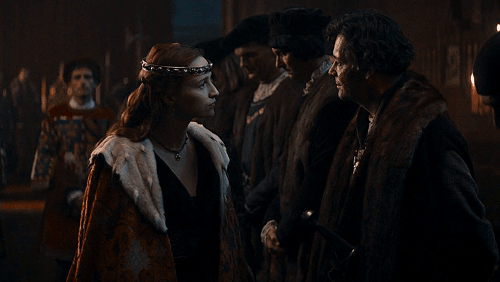
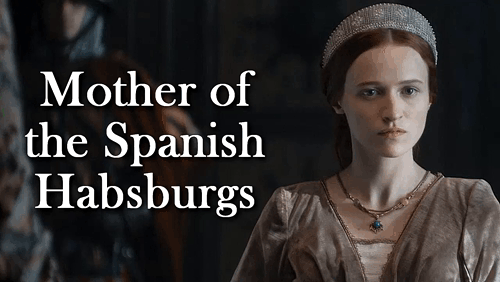


House of Valois & of Habsburg: Mary, The Duchess of Burgundy
Mary was born as the only child of Charles the Bold, The Duke of Burgundy, and his second wife Isabella of Bourbon. Although celebrated lavishly, neither her grandfather nor her father took part in her christening. Her godparents were her paternal grandmother Infanta Isabella of Portugal and King Louis XI. of France, at the time still The Dauphin of France.
For the first six years of her life, she lived with her parents. But when her father became The Governor of Holland, he moved with his wife but without his daughter there. Mary was sent to Ghent to prevent further riots of the citizens there. She was raised bilingual in French and Flemish but always prevered French. Mary received a formal education befitting that of a princess but was never prepared to rule as her parents still hoped for a male heir. This hope ended when Isabella of Bourbon died in 1465. The marriage of Charles and Margaret of York, which happened in 1468, resulted in no further children, keeping Mary as the sole heir.
Margaret, who was only eleven years older than Mary, became one of young woman’s most trusted advisors and friends. Their relationship was described as sisterly. Margaret also taught her stepdaughter the English language.
In 1467, Mary’s grandfather died and her father became The Duke of Burgundy. The 10-year-old Mary was his only living child and became his heir presumptive. Because of that and the wealth the House of Burgundy controlled, she was an interesting marriage candidate. Already five years prior a marriage between the future king of Aragon, Ferdinand II, and her was proposed. Charles, The Duke of Berry - the younger brother of Mary’s godfather King Louis XI of France - approached her as well as Nicholas, The Duke of Lorraine, who was killed in battle in 1473.
The question of a husband would reappear when Mary succeeded her father at the age of only twenty. Her godfather seized the opportunity of a defenseless Mary and invaded great parts of her country. Louis XI presented himself as a patron saint for Mary and demanded of her to marry his only seven-year-old son and heir Charles. Mary also felt pressure from within her country. Only a month after her accession, she had to grant the Great Privilege to her citizens. It included that she had no right to declare war, make peace, or raise taxes without the consent of the provinces and towns and only to employ native residents in official posts.
Mary’s only chance for regaining control was to marry and she did. Archduke Maximilian of Austria, The Holy Roman Emperor’s only son and heir. With their marriage on August 19th, 1477, he became the co-ruler of Burgundy. The couple had three children of whom the two oldest survived into adulthood: Philip the Handsome and Archduchess Margaret of Austria. Philip would later become the first Habsburg king of Castile through his marriage to Queen Joanna “the Mad” of Castile. He was the founder of the Spanish branch of the House of Habsburg. Margaret would marry twice, first becoming The Princess of Asturias and second The Countess of Savoy. Later, she was made the governess of the Habsburg Netherlands by her father after her brother’s death.
Mary of Burgundy died on March 7th, 1482, at the age of only 25 due to injuries she suffered after falling from her horse during a falcon hunt. With her death, her inheritance went to the House of Habsburg through her son Philip. This would lead to a brewing conflict between France and Spain in the following 200 years. If she had not died young, she would have gone on to become Holy Roman Empress through her husband Maximilian I.
// Christa Théret as Mary of Burgundy in Maximilian - Das Spiel von Macht und Liebe
#perioddramaedit#period drama#mary of burgundy#historyedit#historic women#15th century#european history#1400s#house of habsburg#house of valois-burgundy#maximilian - das spiel von macht und liebe#female rulers#austrian history#royal women of austria#House of Valois
541 notes
·
View notes
Text
14th King of Portugal (5th of the Aviz Dynasty): King Manuel I of Portugal, “The Fortunate)

Reign: 25 October 1495 – 13 December 1521
Acclamation: 27 October 1495
Predecessor: João II
Manuel I (31 May 1469 in Alcochete – 13 December 1521 in Lisbon ), the Fortunate (o Venturoso, o Afortunado), King of Portugal, was the son of Fernando, Duke of Viseu,

by his wife, the Infanta Beatriz of Portugal.

His name is associated with a period of Portuguese history distinguished by significant achievements both in political affairs and in the arts. In spite of Portugal's small size and population in comparison to the great European land powers of France, Italy and even Spain, the classical Portuguese Armada was the largest in the world at the time. During Manuel's reign Portugal was able to acquire an overseas empire of vast proportions, the first in world history to reach global dimensions. The landmark symbol of the period was the Portuguese discovery of Brazil and South America in April 1500.

Manuel's mother was the granddaughter of King João I of Portugal,

whereas his father was the second surviving son of King Duarte of Portugal
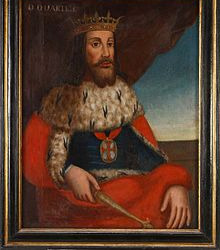
and the younger brother of King Afonso V of Portugal.
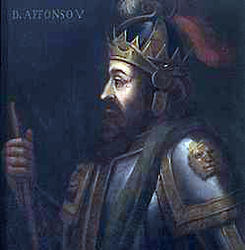
In 1495, Manuel succeeded his first cousin, King João II of Portugal, who was also his brother-in-law, as husband to Manuel's sister, Leonor of Viseu.
Manuel grew up amidst conspiracies of the Portuguese upper nobility against King João II. He was aware of many people being killed and exiled. His older brother Diogo, Duke of Viseu, was stabbed to death in 1484 by the king himself.
Manuel thus would have had every reason to worry when he received a royal order in 1493 to present himself to the king, but his fears were groundless: João II wanted to name him heir to the throne after the death of his son Prince Afonso and the failed attempts to legitimize Jorge, Duke of Coimbra, his illegitimate son. As a result of this stroke of luck, Manuel was nicknamed the Fortunate, and succeeded on João's death in 1495.

Imperial Growth
Manuel would prove a worthy successor to his cousin João II for his support of Portuguese exploration of the Atlantic Ocean and development of Portuguese commerce. During his reign, the following achievements were realized:
1498 – The discovery of a maritime route to India by Vasco da Gama

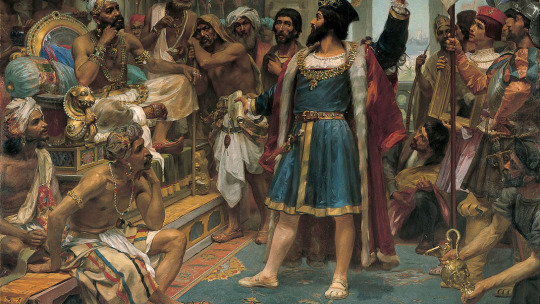
1500 – The discovery of Brazil by Pedro Álvares Cabral.
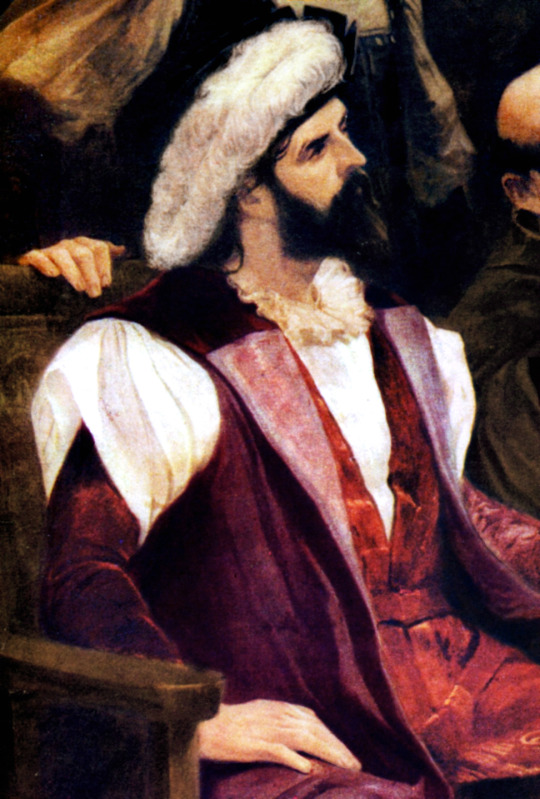
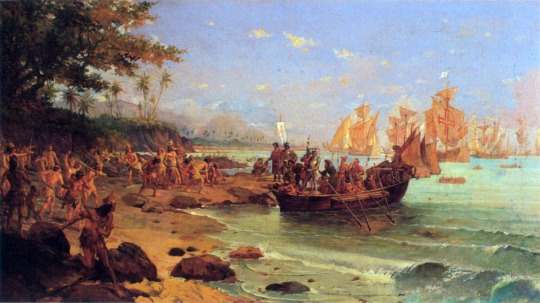
1501 – The discovery of Labrador by Gaspar

and Miguel Corte-Real.

1505 – The appointment of Francisco de Almeida as the first viceroy of India
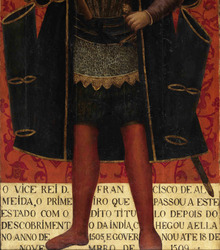
1503–1515 – The establishment of monopolies on maritime trade routes to the Indian Ocean and Persian Gulf by Afonso de Albuquerque, an admiral, for the benefit of Portugal.

The capture of Malacca in modern-day Malaysia in 1511 was the result of a plan by Manuel I to thwart the Muslim trade in the Indian Ocean by capturing Aden, blocking trade through Alexandria, capturing Ormuz to block trade through the Persian Gulf and Beirut, and capturing Malacca to control trade with China.
All these events made Portugal wealthy from foreign trade as it formally established a vast overseas empire. Manuel used the wealth to build a number of royal buildings (in the "Manueline" style) and to attract scientists and artists to his court. Commercial treaties and diplomatic alliances were forged with Ming dynasty of China and the Persian Safavid dynasty. Pope Leo X
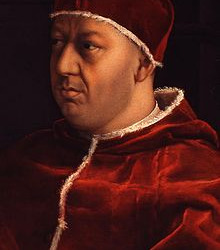
received a monumental embassy from Portugal during his reign designed to draw attention to Portugal's newly acquired riches to all of Europe.
Manueline Ordinations
In Manuel's reign, royal absolutism was the method of government. The Portuguese Cortes (the assembly of the kingdom) met only three times during his reign, always in Lisbon, the king's seat. He reformed the courts of justice and the municipal charters with the crown, modernizing taxes and the concepts of tributes and rights. During his reign, the laws in force in the kingdom of Portugal were recodified with the publication of the Manueline Ordinations.
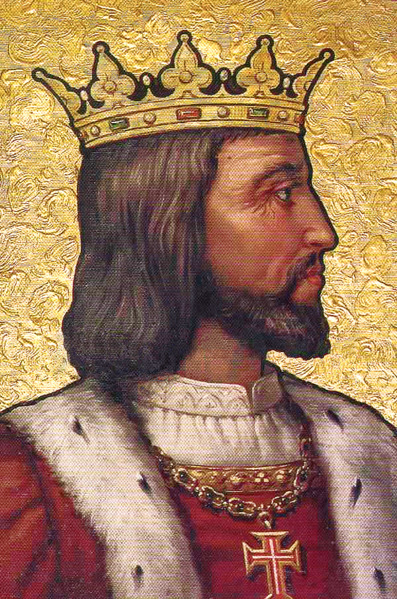
Religious policy
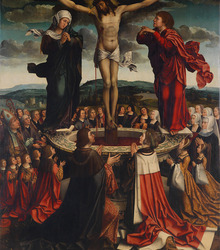
Manuel was a very religious man and invested a large amount of Portuguese income to send missionaries to the new colonies, among them Francisco Álvares, and sponsor the construction of religious buildings, such as the Monastery of Jerónimos.

Manuel also endeavoured to promote another crusade against the Turks.
The Jews in Portugal
His relationship with the Portuguese Jews started out well. At the outset of his reign, he released all the Jews who had been made captive during the reign of João II. Unfortunately for the Jews, he decided that he wanted to marry Infanta Isabel of Aragon,
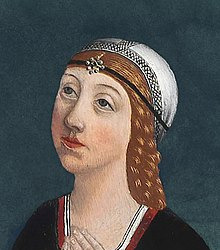
then heiress of the future united crown of Spain (and widow of his nephew Prince Afonso). Her parents Fernando and Isabel had expelled the Jews in 1492 and would never marry their daughter to the king of a country that still tolerated their presence. In the marriage contract, Manuel I agreed to persecute the Jews of Portugal.
In December 1496, it was decreed that all Jews either convert to Christianity or leave the country without their children. However, those expelled could only leave the country in ships specified by the king. When those who chose expulsion arrived at the port in Lisbon, they were met by clerics and soldiers who tried to use coercion and promises in order to baptize them and prevent them from leaving the country.
This period of time technically ended the presence of Jews in Portugal. Afterwards, all converted Jews and their descendants would be referred to as "New Christians", and they were given a grace period of thirty years in which no inquiries into their faith would be allowed; this was later extended to end in 1534.
During the course of the Lisbon massacre of 1506, people invaded the Jewish Quarter and murdered thousands of accused Jews; the leaders of the riot were executed by Manuel.
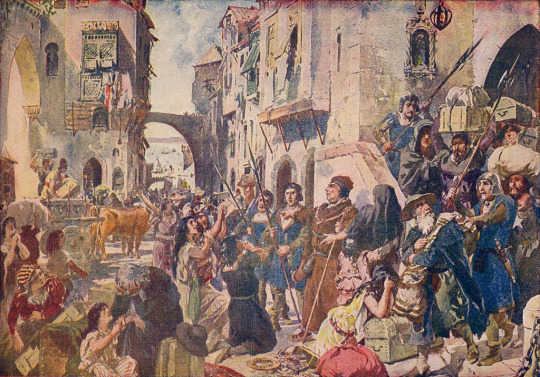
Isabel died in childbirth in 1498, thus putting a damper on Portuguese ambitions to rule in Spain, which various rulers had harbored since the reign of King Fernando I (1367–1383).

Manuel and Isabel's young son Miguel
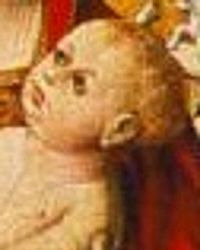
was for a period the heir apparent of Castile and Aragon, but his death in 1500 at the age of two years ended these ambitions.
Manuel's next wife, Maria of Aragon,

was his first wife's younger sister. Two of their sons later became kings of Portugal. Maria died in 1517 but the two sisters were survived by an older sister, Joana of Castile, who was born in 1479 and had married the Archduke Philip (Maximilian I's son) and had a son, Charles V who would eventually inherit Spain and the Habsburg possessions.
Manuel I was awarded the Golden Rose by Pope Julius II in 1506 and by Pope Leo X in 1514. Manuel I became the first individual to receive more than one Golden Rose after Emperor Sigismund von Luxembourg.
Manuel died of unknown causes on December 13 of 1521 at age 52. The Jerónimos Monastery in Lisbon houses Manuel's and Maria’s tombs. His son João succeeded him as king.


Negotiations for a marriage between Manuel and Elizabeth of York

in 1485 were halted by the death of Richard III of England.
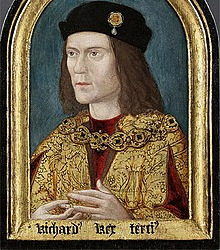
He went on to marry three times. His first wife was Isabel of Aragon, princess of Spain and widow of the previous Prince of Portugal Afonso. Next, he married another princess of Spain, Maria of Aragon (his first wife's sister), and then Leonor of Austria,
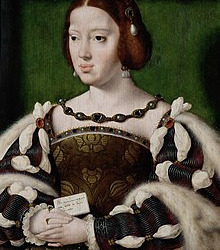
a niece of his first two wives, who married Francis I of France

after Manuel's death.
By Isabella of Aragon (2 October 1470 – 28 August 1498; married in 1497)
Miguel da Paz, Prince of Portugal (23 August 1498 - 19 July 1500) 1 year 10 months - Prince of Portugal, Prince of Asturias and heir to the crowns of Portugal, Castile, and Aragon.
By Maria of Aragon (19 June 1482 – 7 March 1517; married in 1500)
João, Prince of Portugal (7 June 1502 - 11 June 1557), 55 years - Succeeded the throne as João III, King of Portugal.
Infanta Isabel (24 October 1503 - 1 May 1539), 35 years - Holy Roman Empress by marriage to Charles V, Holy Roman Emperor.

Infanta Beatriz (31 December 1504 - 8 January 1538), 33 years - Duchess of Savoy by marriage to Charles III, Duke of Savoy.
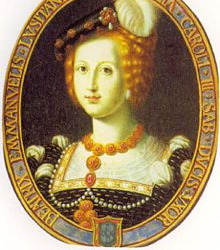
Infante Luís (3 March 1506 - 27 November 1555), 49 years - Duke of Beja. Unmarried but had illegitimate descendants, one of them being António, Prior of Crato, a claimant of the throne of Portugal in 1580; see: Portuguese succession crisis of 1580.
Infante Fernando (5 June 1507 - 7 November 1534), 27 years - Duke of Guarda. Married Guiomar Coutinho, 5th Countess of Marialva and 3rd Countess of Loulé (died 1534). No surviving issue.
Infante Afonso (23 April 1509 - 21 April 1540) 30 years - Cardinal of the Roman Catholic Church
Infante Henrique (31 January 1512 - 31 January 1580), 68 years - Cardinal of the Roman Catholic Church who succeeded his grandnephew, King Sebastião (Manuel I's great-grandson), as Cardinal Henrique, King of Portugal. His death triggered the Portuguese succession crisis of 1580.
Infanta Maria (3 February 1513) Died immediately after birth.
Infante Duarte (7 October 1515 - 20 September 1540), 24 years - Duke of Guimarães and great-grandfather of João IV of Portugal. Married Isabel of Bragança, daughter of Jaime, Duke of Bragança.
Infante António (9 September 1516) - Died immediately after birth.
By Leonor of Austria (15 November 1498 – 25 February 1558; married in 1518)
Infante Carlos (18 February 1520 - 14 April 1521), 1 year 1 month
Infanta Maria (18 June 1521 - 10 October 1577) 56 years - Unmarried
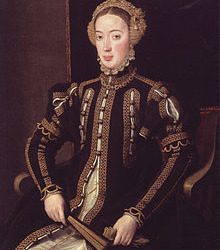
11 notes
·
View notes
Photo

On the 2nd of October 1452, Cecily Neville gave birth to her youngest son at Fortheringhay Castle. Years after his death, Tudor chroniclers wrote fantastical tales about his birth. More said that she was in “much doe in her travail” and that he was born with a full set of hair and crooked teeth. There is no actual record of the birth and the chronicler of the Neville family, Rous, wrote that he was healthy and he “liveth yet”. The reason why he said this was because Cecily became pregnant again three years after and gave birth to a girl who died that same year. Also, infant mortality was high so the fact he survived was something to take into account.
At the age of seven, Richard was exposed to the realities of war. It is written that she was “despoiled” of her goods, and while this could mean rape, it could also mean that they looted her house. The latter was still a big humiliation, to see her possessions being taken by common men and soldiers.
Cecily went to the city of Coventry where Parliament was held (a parliament that became known as “Parliament of Devils”) and submitted herself to royal mercy. But at this point, tensions were too high and it was clear that only one victor could emerge from this conflict.
“Without her husband by her side, Cecily had little choice but to submit to the rule of Henry VI and was placed in the custody of her sister Anne at Tonbridge Castle in Kent.” (Licence)
Anne was the Duchess of Buckingham through her marriage to John Stafford and as such, a staunch Lancastrian. Initially Cecily took her sons with her, but in the end she decided to send them away to Burgundy.
Sarah Gristwood in her biography notes that the “comparative lenience with which Cecily was treated was the result of her friendship with Queen Marguerite” yet she also notes what the chroniclers at the time said, that she was kept “full straight with many a rebuke” from her sister. “The future prominence of Cecily’s son” Gristwood points out, referring to her eldest, Edward the Earl of March “had never looked more unlikely.”
In 1460 however, the Yorkists scored a major victory when they took control of the capital and forced Henry VI to recognize the Duke of York as his heir. Cecily was sent for and the couple were not only Duke and Duchess of York anymore, but by right they were Prince and Princess of Wales. But things took a turn for the worse on that December when Marguerite’s troops took them by surprise at Sandal Castle and killed everyone, including Cecily’s brother, nephew, and her second son Edmund, the Earl of Rutland.
It wasn’t until 1461, when Richard’s oldest brother became King, that the family finally felt secure. Edward IV made Dukes of him and George. Richard was awarded the title of Duke of Gloucester. And then the rest –as they say- is history when he decided to marry a Lancastrian widow over Warwick’s proposal with Bona of Savoy. This split the Yorkist house in two ending with his cousin Warwick’s death in the battle of Barnet, the destruction of the Lancastrian, and seven years later the execution of his brother George. And then Edward died (possibly as a result of a cold, although Mancini said it was because of his “vices”) and the crown was free for the taking. It is very possible that Richard didn’t intend to take the crown at first like later Tudor version depict, but rather like his father, gain control of his nephew since he believed he was more suited to do so then the boy’s maternal relatives who were very hated with the nobility. But as the Queen locked herself in sanctuary, and then fearing repercussion from her relatives and allies, he executed her brother and his brother’s allies; he realized things had gone too far. And once again, like his father he was going to make a move that changed the history of the dynasty.
He and his wife, Anne Neville were crowned on July of that year, with their only son Edward of Middleham invested as Prince of Wales later that autumn in the North.
Although the Lancastrian royal line was wiped out, one scion remained and even though some considered his mother’s line a bastard line, many still saw him as the heir to the Lancastrian cause, and Edwardian Yorkists who were not too happy with Richard’s rule fled to Brittany to join him in his exile. The youth’s name was Henry Tudor, and like Richard, he had been privy to the horrors of war at a young age.
Richard ruled for over two years. And to this day, he is the hot topic of almost every conversation regarding the wars of the roses. Was he a good or bad king? Or was he a victim of circumstance?
It is easier to say as one historian once said in an interview, that he was neither. On one front we have him doing great things for the country such as improving the law courts and allowing more common people to have representation, and he was very loved in the North; on the other hand we also have him be as ruthless as any king could be in this era, and executing as many as he saw fit to keep his power.
The rumors of him poisoning his wife are of course exaggerated, he probably loved her but as King he had to think of the future of his dynasty. When their son died in 1484 and she became sick with grief (dying the following year), he was looking for someone else to marry. He publicly denied that he wanted to marry his niece, Elizabeth of York and while he could have contemplated that (at one point), it seems highly unlikely that he would have done that in the end. His intentions in the summer of 1485 reflect that, when he was negotiating for a joint marriage for himself and his niece (Elizabeth) to a Portuguese Princess and Duke.
20 notes
·
View notes
Text
The beginning of an AU historical fiction about a legitimate daughter of King Charles II of England and Queen Catherine of Braganza, Princess Catherine ‘Kitty’ Stuart.
Today, I am sixteen.
When I was born, in the sweltering summer of 1663, it nearly killed my mother. She barely remembers, of course, I suppose she slipped in and out of this world as I was prized out of her and the memory lives in a haze. But even she, weary as she was, could not keep from asking the question that had hung in the heated atmosphere of her chamber in the preceding hours. Nay, the question had been on every courtiers’ lips since they saw that my mama was big with me a few months earlier. It found its way into every nook and cranny of the palace until it nearly drove my father out of his wits with worry and my mother into floods of tears as she felt her grip on what was expected of her in this new, alien land, loosen.
Will it live?
Then, suddenly, like the crack in the sky on earth’s first day, a cry. A yell.
‘The child lives, your Majesty!’
More wailing. My mother registered it, like a light in the mist, and continued on, anxiously.
‘A son? Um príncipe?’
A brief silence. Held breaths and anxious glances punctuated it.
‘Tis a perfectly healthy girl, your Majesty. Uma princesa!’
Now, my mother is ashamed to own that, at this, she let out one, single sob. In this sob, there was her oft-strangled desire to go home, back to Portugal, to her family. To leave this bleak, wet, heretic kingdom where she was barely trusted and had to look her husband’s concubine in the eye as she dressed her for dinner and chapel. And her only saving grace, in all this, was her ability to bear children, male heirs and prove herself a worthy investment, an obedient daughter, a good queen, and an accomplished woman. That whore, Castlemaine, would never again have had the gall to utter more than ‘Yea’ or ‘Nay’ in her presence had I been a boy, a prince. Alas, it was not to be. I am a girl. God’s will be done.
My father, my glorious father, did not hold the same reservations as mama.
‘Catherine, you clever, brilliant, beautiful creature! You brave, sweet girl!’ he had said, through tears of relief and joy, when he was finally allowed in to see us both, my mother and I.
‘It is a girl, your Majesty. I beg you would not pretend happiness.’
‘Happy? Catherine, I am more than that! I am quite paralysed with the joy of it. And I am relieved that you are well, too.’
Mama has oft told me since that when he reached across the silken covers to kiss her forehead, her sadness began to ebb. Perhaps, she had thought, it was not so bad. We all lived to see another day, after all. She had been holding me in her arms all the while but now she suddenly felt me, realised my weight, understood my shape, and noticed a tiny but fierce heartbeat.
‘She is a very beautiful baby’ she said, finally, looking at me properly now and feeling a pull from all directions, to embrace everything she loved, even in this cold little heretic backwater.
‘She is the prettiest lady in the kingdom. Only a little prettier than her sweet mother, I daresay.’
‘You are not sad that she is a girl? You would not prefer a son, sir?’
‘My dearest queen, she is born of you and I and increases my happiness by the minute. If she were a son, I should feel the same.’
My mother was charmed. This man, this king, was a strange, benevolent man, she thought, and she liked him all the better for it.
‘I suppose she is a princess.’
‘Yes, indeed.’ Papa was scooping me up in his own arms now, for the first time, though he had needed no encouragement to love me.
‘Princess Catherine Henrietta Mary Stuart of England!’ he declared, in his magnificent voice, all full of richness.
‘And Scotland, Ireland and France, Charles.’ My uncle, Jamie, the Duke of York, had arrived by now and was in the door way, trying to scowl, but apparently, as hard as it is to believe, even he found the joy infectious.
‘Details, Jamie. No matter, for she is so beautiful that she should be queen of the whole world, I will wager! Oh, my darling princess, how your father loves thee!’
And so, with that, I was set out on my way. To grow daily in the glorious shadow of my father, King Charles Stuart of England (and Scotland, Ireland and France!), the second of that name, loved intensely by him and my mother, Queen Catherine, who was once a princess of the Most Serene House of Braganza. I am their only legitimate child, a female heir in a world where women are not much listened to. There are always mutterings, most especially amongst the French members of my family and my cousin, King Louis of France, that a son is still preferable. I have the education of a prince, the shooting skills of a country squire, the music skills of a maestro, a little slew of feminine charms but lacking any real womanly beauty, and the wit of a libertine. But, perhaps, after all, they are right. Perhaps a prince would be best.
But today, I do not care. Because today, I am sixteen. And England, the centre of my universe, toasts to my good health and long life.
#my writing#we are gonna pop the biggest bottles if I actually carry on with this#I'm literally nicking maids of honour from anne hyde and young queen anne and queen Mary ii for Kitty lmao#TBH I've had the kitty stuart au for years#I have her husband and stuff already planned out#history
44 notes
·
View notes
Photo

Victims of the Childbed - Anne de Mortimer
Anne was the firstborn of Roger Mortimer, 4th Earl of March and Alianor Holland. The Mortimer family held a large amount of land in Ireland, so Anne and her three younger siblings were born at the family estate in Westmeath. The Mortimer children came from a long and twisted line of royal connections. Through her mother Alianor, Anne was descended from both Henry III and Edward I. It was her father Roger who boasted the all-important link to Edward III, for his maternal grandfather was Lionel of Antwerp, Edward’s second surviving son. As such, Roger was the heir apparent to childless King Richard II according to the laws of primogeniture. But in 1398 when Roger was killed fighting the Irish at Kells, his claim passed to his eldest son, Anne’s brother Edmund.
The lives of Anne and her siblings became much more difficult following the death of their father and the overthrow of Richard II in 1399. Richard was deposed by his cousin Henry Bolingbroke, who took the throne as Henry IV. Because of the strength of their claims (which were arguably stronger than his own), the Mortimer children were potential threats to Henry’s power. As a preventative measure, Anne’s brothers Edmund and Roger were imprisoned in Berkhamstead Castle but well treated. Meanwhile, Anne and her baby sister Eleanor were left with their mother. Disaster struck again in 1405 when Alianor died, leaving fifteen-year-old Anne and ten-year-old Eleanor quite alone. They lived in a relatively impoverished state for members of the extended royal family. The king was not kindly disposed towards the Mortimer family and gave Anne an annual sum of just £50 for maintenance. This probably also had the effect of devaluing her as a bride.
At sixteen it must have seemed that marriage or religious life were the only ways out of Anne’s situation. She had no dowry and only a small royal allowance, which would make it difficult to find a match in her own class. However, in May of 1406 she married Richard of Conisburgh. Richard was a grandson of Edward III through his father Edmund, Duke of York. Thus, the marriage of Anne and Richard joined two strong claims to the English throne. It is unclear why the marriage even took place, as neither party gained anything. Richard was another “poor” royal relation like Anne. They also married without the consent of family or the king and did not get the consent of the Pope until two years later. (The romantic in me wants to believe it was a love match.) Nevertheless, Anne’s marriage laid the foundation stones for what would be known as the House of York.
Anne and Richard’s first child, Isabel of York, was born in 1409. Around a year later Anne gave birth to a son, Henry, who died in infancy. On September 21, 1411 Anne gave birth to a second boy. She did not live long after, probably dying the following day at the age of twenty. Her son was named Richard after his father. Four years after Anne’s death, her husband was involved in the Southampton Plot to depose Henry V and place Anne’s brother Edmund on the throne. He was caught and subsequently beheaded. At the age of four, little Richard of York inherited his father’s titles and would later succeed his paternal uncle as Duke of York. Richard’s leading role in the early days of the Wars of the Roses has become legendary. Through him, Anne is the grandmother of Edward IV and Richard III, and is an ancestor of all English monarchs after Henry VII.
#I made her chubby because she's Edward IV's grandma#so I have decreed that Elizabeth of York took after her great-grandmother hold your applause#didn't give her a whole lot of adornment bc I don't think she was particularly well off#so this is her 'best dress'#Anne de Mortimer#Plantagenet#house of York#medieval#Richard of York#victims of the childbed#art#my art
130 notes
·
View notes
Photo

ON THIS DAY IN HISTORY . 30 December 1460 . Wars of the Roses: The Battle of Wakefield . . ◼ The Battle of Wakefield took place in Sandal Magna near Wakefield, in West Yorkshire in Northern England, on 30 December 1460. It was a major battle of the Wars of the Roses. . ◼ For several years before the battle, the Duke of York had become increasingly opposed to the weak King Henry VI's court. After King Henry became his prisoner for the second time, he laid claim to the throne, but lacked sufficient support. Instead, he accepted the title of Protector, & a promise that he or his heirs would succeed Henry. Margaret of Anjou & several prominent nobles were irreconcilably opposed to this accord, & massed their armies in the north. Richard of York marched north to deal with them, but found he was outnumbered. . ◼ The opposing forces were an army led by nobles loyal to the captive King Henry VI of the House of Lancaster, his Queen Margaret of Anjou & their seven year-old son Edward, Prince of Wales on one side, & the army of Richard, Duke of York (father of Edward IV & Richard III), the rival claimant to the throne, on the other. . ◼ Although he occupied Sandal Castle, the Duke of York sortied from the castle on 30 December. His reasons for doing so have been variously ascribed to deception by the Lancastrian armies, or treachery by some nobles & Lancastrian officers who York thought were his allies, or simple rashness or miscalculation by York. The Duke of York was killed & his army was destroyed, many of the prominent Yorkist leaders & their family members died in the battle or were captured & executed. . ◼ One near-contemporary source (Gregory's Chronicle) claimed that 2,500 Yorkists & 200 Lancastrians were killed, but other sources give wildly differing figures, from 2,200 to only 700 Yorkist dead. . . . . #ONTHISDAYINHISTORY #thisdayinhistory#TheYear1460, #History #EnglishHistory #BattleofWakefield #WarsoftheRoses #KingHenryVI #HouseofLancaster #MargaretofAnjou #RichardDukeofYork #HouseofPlantagenet #HouseofYork #HouseofLancaster #SandalCastle #d30dec (at Wakefield) https://www.instagram.com/p/BsBBWuQFTZh/?utm_source=ig_tumblr_share&igshid=11lpanvwhxs9a
#onthisdayinhistory#thisdayinhistory#theyear1460#history#englishhistory#battleofwakefield#warsoftheroses#kinghenryvi#houseoflancaster#margaretofanjou#richarddukeofyork#houseofplantagenet#houseofyork#sandalcastle#d30dec
2 notes
·
View notes
Text
The First Commoner Queen
On this day in history the 8th of June 1492, Dowager Queen Elizabeth Wydeville died in her home in Bermondsey Abbey, Surrey.
She was born circa 1437 at Grafton Regis, Northamptonshire. Her parents were unequal in status in the English court. Her father Sir Richard Wydeville was only a Knight. Her mother Jacquetta of Luxemburg was of high rank! She could have even became queen. Her first husband being John of Lancaster, 1st Earl Bedford.

Despite the scandalouus marraige Elizabeth was their first of fourteen children. Not much is known of her childhood but she was educated enough due to her family's Gentry status. They had land and wealth but were by no means noble.
At the age of only fifteen Elizabeth was married to John Grey of Groby with whom she had two sons. Richard Grey and Thomas Grey. They had a happy marraige but John was killed in the Second Battle of St. Albans in 1461 leaving Elizabeth a twenty three year old widow of two sons.
In April of 1464 Elizabeth met her second husband. King Edward of York. He was a twenty two year old man who was noted to be particularly handsome. Although it is not known exactly when they married but historians estimate it to be on the 1st of May 1464 in her family home in Northhampshire.
Their marraige was announced in court later the same year. Edward's cousin was not happy. Elizabeth was a commoner and of a Lancastrian family. Edward Neville, Earl of Warwick had tried to negotiate with France for Edward to marry a French princess.
She proved to be just like her parents. Not afraid of a little scandal! She was coronated Queen Consort of England on the 26th of May 1465.
The following year she gave birth to her first of ten Royal children. Elizabeth of York was born on the 11th of February 1466. Although Elizabeth and Edward were delighted with the birth of their first child, many looked down on Elizabeth for not giving the king a son and heir. This particular child was very important as she would one day become Queen of England. She died after giving birth to her eighth child Katherine on her 37th birthday.
The year after on the 11th of August Mary of York arrived. The couple were yet again overjoyed. Edward was devoted to his wife even though he did have a mistress. Every child born he ordered great celebrations. Many wondered why when a girl had been born. Edward lnew sons could rule but daughters could create strong alliances through marraige. Mary died on the 23rd of May 1482.
On the 20th of March 1469 Cecily of York was born. She was named after her paternal grandmother, Cecily Neville The Duchess of York.
In 1470 Edward was deposed and Henry VI was restored to the throne. Elizabeth fled with her daughters to Westminster Abbey to seek sanctuary. She and her daughters were brought to the Royal apartments. It was here Elizabeth found out she was yet again pregnant. She gave birth with the aid of her mother to a son. On the 2nd of November 1470 Edward Plantagenet, Prince of Wales was born. He became king upon the death of his father but was never coronated. He was the older of the two Princes in the Tower. Elizabeth was overjoyed. She'd finally given her husband a son amd heir. She'd helped to secure the York dynasty.
Margaret of York came on the 10th of April 1472. She didnt survive infancy and died in December of 1472. She is buried in Westminster Abbey.
A Duke of York was born on the 17th of August 1473. Richard of Shrewsbury was the so called 'spare' and made his family proud. Sadlt he was the ypunger of rhe two Princes in the Tower. He was only nine when he disappeared.
Anne of York was born on the 2nd of November 1475. She too was her family's pride and joy. Her sister made sure she was married well and was happy.
George, Duke of Bedford was born Early March of 1477. It isnt known for sure his actual date of birth but this poor little fella didnt survive. He died in 1479.
The next little bundle of joy was Catherine of York. She was born 14th of August 1479. She was Countess of Devon. She survived well into the reign of her nephew Henry VIII dying in 1527.
Elizabeth's final chil was Bridget of York. She was born on the 10th of November 1480. At the age of ten she entered a convent and devoted her life to God. She even studied the saints, her work still surviving. She died in 1517 in Dartford Priory, Kent
Elizabeth never conceived again. She gave the king two sons and by the end of his reign she had five surviving daughters. Sadly their happiness was not to last. In late March of 1483, Edward IV developed a chill. He thought it was merely a cold. He became weak and had to retire to bed. As the days went on Elizabeth tried to nurse her husband with their doctors. She did not leave his side. She was even with him when he took his last breath. On the 9th of April 1483 Edward IV died.
Elizabeth was now Dowager Queen. She had to ensure her son took the throne peacefully. Richard Plantagenet, Duke of Gloucester was made Lord Protector while young Edward V was in his minority.
Elizabeth did not trust Richard and took her five daughters and only remaining son Richard to Westminster Abbey to seek sanctuary. She feared that they would be imprisoned or worse killed.
Her son now King Edward V was brought from Ludlow Castle to the Tower of London until his coronation. Richard Plantagenet asked for Richard to be taken from his mother to accompany his brother in the Tower and help him prepare for his coronation. Elizabeth reluctantly agreed. This would be a huge mistake.
She never saw her sons again. They disappeared from the Tower. Many theories circle around this to this day. Were they smuggled to safety, suffocated as they slept in their beds? Maybe we will never truly know what became of these boys. Maybe on this day Elizabeth found out.
As her sons were in the Tower her marriage to Edward IV was made invalid due to Edward being precontracted to a Lady Eleanor Talbot. Her sons were made illegitimate and this tore Edward's claim to the throne from him. Her daughters were now Ladies rather than Princesses and had no claim to any inheritance. This angered Elizabeth. Her children were not bastards. They were legitimate. They had a birth right!
Richard Plantagenet, Duke of Gloucester took the throne as Richard III. Elizabeth was furious and wanted to know of what became of her beloved son. Her brother Anthony Wydeville, 2nd Earl Rivers and Thomas Grey her older son were executed on Richard's orders. She wanted revenge.
She made a plan with Lady Margaret Beaufort that her only son Henry Tudor would marry her oldest daughter Elizabeth of York and unite the houses to end this bloody civil war.
Her daughters left sanctuary in March of 1484 to attend to Queen Anne. Richard promised Elizabeth her daughters woukd be married ti gentlemen of the court and they woukd nit be molested or belittled. This is when the rumours began. Rumours that Richard had taken his neice on as a mistress began to circulate the court. I beleive it to be false. Richard had four children. Three being illegitimate. John, Catherine and another I have completely forgotton (I apologise) and his son Edward of Middleham wad bis onpy legitimate child. If he did take Elizabeth as a miatress then surely she would have fallen pregnant. She had eight children for her husband and the first arriving the same year as their marraige. Sirely she was never anyones mistress if she was that fertile.
. Elizabeth of York often visited her mother and Elizabeth Wydeville knew full well everything that was going on. She wasnt a fool! She'd sent her older daughters to court
Over the next year Elizabeth Wydeville planned a rebellion with Margaret Beaufort. Richard was desperate. He lost his only legitimate son and his wife. He needed an heir and fast. Henry Tudor landed on the 7th of August 1485 with over eight thousand men. He was determined to win this fight and become King of England.
Elizabeth and her daughters were sent to the country where they'd be safe while Richard fought in Battle. Elizabeth and her five daughters enjoyed a life of luxury while here. They wanted for nothing. Even her younger children Bridget and Catherine were given the finest dresses as they grew since they were only five and six years of age.
Elizabeth heard news that Richard III was slain at the Battle of Bosworth a day later. Days after Henry's men escorted Elizabeth and her daughters to London to meet the king.
Henry was taken back by her daughter's beauty. He was reported to have stared at Elizabeth's oldest daughter like a young boy. Elizabeth of York was known for her beauty. She was his fiance and this was the reaction Dowager Queen Elizabeth Wydeville hoped for.
Elizabeth and her daughters lived in Westminster Palace where many of her children had been born. She had many good memories there and she considered it home. She did not attend the coronation of her future son in law but she was present at the Royal Wedding on the 18th of January 1486.


During the Summer Progress of 1486 Elizabeth had attended her daughter in her confinment. She and Lady Margaret Beaufort ensured Elizabeth followed the strict rules until she was to give birth
On the 20th of September 1486 she welcomed her first grandchild. A boy named Arthur. She was said to have been overjoyed although she was not present at the birth. She was present at his christening days later. He was christened in Winchester the supposed location of the legendary Round Table.
Elizabeth last public appearance was in November of 1487 when her oldest daughter Elizabeth of York was crowned Queen Consort of England.
She retired to the Abbey in 1487 after her daughter's coranation. She spent many joy filled years here with her daughters before they were brought to court or in Bridget's case went to a nunnery.
She always wrote to her daughters and always made sure they were treated as they were supposed to be. It was this day in history that Dowager Queen Elizabeth Wydeville passed. She was finally with her husband and the children she lost.
Elizabeth Wydeville was the grandmother of the Tudor Dynasty and her hair and eyes were inherited by every Tudor besides Queen Mary I. She was the only Tudor without blue eyes.
If it were not for the rise of Elizabeth Wydeville women like Anne Boleyn would not be able to rise to such a high status as Queen. She was truly a legendary woman.
#onthisday#elizabeth of york#plantagenets#warsoftheroses#edwardiv#queen elizabeth#cousinswar#history#thisdayinhistory#on this day#princes in the tower#thecousinswar
61 notes
·
View notes
Photo

Henri II un anglo franco normardo que comienza una saga que explica las capas tectónicas de la historia de la dominación anglo-germana católica romana en Hispania/ Al- Andalus/ Sefarad. Se ve cómo entre ellos se casan, se matan, se reproducen y se pasan los territorios como pelotas. Guerras y competencias pero siempre entre las familias.
House of Plantagenet
Henry II
(1154–1189) is considered by some to be the first Plantagenet king of England.
Richard of York, 3rd Duke of York, adopted Plantagenet as his family name in the 15th century. Plantegenest (or Plante Genest) had been a 12th-century nickname for his ancestor Geoffrey, Count of Anjou and Duke of Normandy. One of many popular theories suggests the common broom, planta genista in medieval Latin, as the source of the nickname.[1]
Los Angenvins
Angevin kings of England //// Angevin Empire
Angevin is French for "from Anjou". The three Angevin kings were Henry II, Richard I and John. "Angevin" can also refer to the period of history in which they reigned. Many historians identify the Angevins as a distinct English royal house. "Angevin" is also used in reference to any sovereign or government derived from Anjou. As a noun, it refers to any native of Anjou or an Angevin ruler, and specifically to other counts and dukes of Anjou, including the ancestors of the three kings who formed the English royal house; their cousins, who held the crown of Jerusalem; and to unrelated members of the French royal family who were later granted the titles and formed different dynasties, such as the Capetian House of Anjou and the Valois House of Anjou.[4] Consequently, there is disagreement between those who consider Henry III to be the first Plantagenet monarch, and those who do not distinguish between Angevins and Plantagenets and therefore consider the first Plantagenet to be Henry II.[5][6][7][8]
Angevin zenith
Of Henry's siblings, William and Geoffrey died unmarried and childless, but the tempestuous marriage of Henry and Eleanor, who already had two daughters (Marie and Alix) through her first marriage to King Louis, produced eight children in thirteen years:[22]
William IX, Count of Poitiers (1153–1156)
Henry the Young King (1155–1183)
Matilda, Duchess of Saxony (1156–1189)—married Henry the Lion, Duke of Bavaria. The eldest amongst the couple's children, Richenza, is probably the daughter English chroniclers call Matilda, who was left in Normandy with her grandparents in 1185 and married firstly to Geoffrey, count of Perche, and secondly to Enguerrand de Coucy. The eldest son, Henry, became duke of Saxony and count palatine of the Rhine. His brother Otto was nominated by his uncle Richard I as earl of York and count of Poitiers before being elected emperor in opposition to the Hohenstaufen candidate. Otto was crowned in Rome but he was later excommunicated and declared deposed. Childless, Otto lost power following the defeat of the Welf and Angevin forces at the Battle of Bouvines. The youngest child, William of Winchester married Helena daughter of Valdemar I of Denmark. Their only son, also called Otto, was the sole male heir of his uncle Henry. The ducal house of Brunswick-Lüneburg and the British royal house of Windsor both descend from him.[23]
Richard I, King of England (1157–1199). He had no legitimate offspring, but is thought to have had two illegitimate sons, of whom little is known, called Fulk and Phillip, Lord of Cognac.[24]
Geoffrey II, Duke of Brittany (1158–1186)—married Constance daughter of Duke Conan of Brittany and became duke of Brittany by right of his wife. The couple's son Arthur was a competitor to John for the Angevin succession.[25]
Eleanor, Queen of Castile (1161–1214)—married King Alfonso VIII of Castile. The couple's children included King Henry of Castile and four queen consorts, Berengaria, Queen of Leon, Urraca, Queen of Portugal, Blanche, Queen of France and Eleanor, Queen of Aragon.[26]
Joan, Queen of Sicily (1165–1199)—married firstly King William II of Sicily and secondly Count Raymond VI of Toulouse. Her children included Raymond VII of Toulouse.[27]
John, King of England (1166–1216)
La historia se perpetua en varias generaciones y matrimonios que dejan claro que el norte de la peninsula lógicamente por mar se corresponde con Inglaterra y Francia por igual.
Henry III had nine children:[59]
Edward I (1239–1307)
Margaret of England (1240–1275). Her three children predeceased her husband, Alexander III of Scotland; consequently, the crown of Scotland became vacant on the death of their only grandchild, Margaret, Maid of Norway in 1290.[60]
Beatrice, Countess of Richmond (1242–1275). She initially married John de Montfort of Dreux, and later married John II, Duke of Brittany.
Edmund Crouchback (1245–1296), who was granted the titles and estates of Simon de Montfort, 6th Earl of Leicester and the earldom of Leicester after Henry defeated Montfort in the Second Barons' War. Henry later granted Edmund the earldoms of Lancaster and Ferrers. From 1276, through his wife, Edmund was Count of Champagne and Brie.[61] Later Lancastrians would attempt to use Henry IV's maternal descent from Edmund to legitimise his claim to the throne, spuriously claiming that Edmund was the eldest son of Henry III but had not become king due to deformity.[62] Through his second marriage to Blanche, the widow of Henry I of Navarre, Edmund was at the centre of European aristocracy. Blanche's daughter, Joan, was queen regnant of Navarre and queen consort of France through her marriage to Philip IV. Edmund's son Thomas became the most powerful nobleman in England, adding to his inheritance the earldoms of Lincoln and Salisbury through his marriage to the heiress of Henry de Lacy, 3rd Earl of Lincoln.[63]
Four others who died as children: Richard (1247–1256), John (1250–1256), William (c. 1251/1252–1256), Katherine (c. 1252/3–1257) and Henry (no recorded dates).
Henry was bankrupted by his military expenditure and general extravagance. The pope offered Henry's brother Richard the Kingdom of Sicily, but the military cost of displacing the incumbent Emperor Frederick was prohibitive. Matthew Paris wrote that Richard stated: "You might as well say, 'I make you a present of the moon – step up to the sky and take it down'." Instead, Henry purchased the kingdom for his son Edmund, which angered many powerful barons. The barons led by Henry's brother-in-law Simon de Montfort forced him to agree to the Provisions of Oxford, under which his debts were paid in exchange for substantial reforms. In France, with the Treaty of Paris, Henry formally surrendered the territory of his Angevin ancestors to Louis IX of France, receiving in return the title duke of Aquitaine and the territory of Gascony as a vassal of the French king.[43]
Death of Simon de Montfort at the
Battle of Evesham
Disagreements between the barons and the king intensified. The barons, under Simon de Montfort, 6th Earl of Leicester, captured most of southeast England in the Second Barons' War. At the Battle of Lewesin 1264, Henry and Prince Edward were defeated and taken prisoner. De Montfort assembled the Great Parliament, recognized as the first Parliament because it was the first time the cities and boroughs had sent representatives.[64] Edward escaped, raised an army and defeated and killed de Montfort at the Battle of Evesham in 1265.[65] Savage retribution was inflicted upon the rebels, and authority restored to Henry. With the realm now peaceful, Edward left England to join Louis IX on the Ninth Crusade; he was one of the last crusaders. Louis died before Edward's arrival, but Edward decided to continue. The result was disappointing; Edward's small force only enabled him to capture Acre and launch a handful of raids. After surviving an assassination attempt, Edward left for Sicily later in the year, never to participate in a crusade again. When Henry III died, Edward acceded to the throne; the barons swore allegiance to him even though he did not return for two years.[65]
Constitutional change and the reform of feudalism
Edward I married Eleanor of Castile, daughter of King Ferdinand of Castile, a great grandson of Henry II through his second daughter Eleanor in 1254. Edward and Eleanor had sixteen children; five daughters survived to adulthood, but only one son survived Edward:[66]
Eleanor, Countess of Bar (1264/69−1298)
Three daughters (Joan, Alice, and Juliana/Katherine) and two sons (John and Henry) born between 1265 and 1271. They died between 1265 and 1274 with little historical trace.
Joan, Countess of Gloucester (1272–1307)
Alphonso, Earl of Chester (1273–1284)
Margaret, Duchess of Brabant (1275–1333)
Mary of Woodstock (1278–1332), who became a nun
Isabella (1279–1279)
Elizabeth, firstly Countess of Holland and on widowhood, secondly Countess of Hereford (1282–1316). Among her eleven children were the earls of Hereford, Essex, and Northampton, and the countesses of Ormond and Devon.
Edward II
Two other daughters (Beatrice and Blanche), who died as children.
Following Eleanor's death in 1290, Edward married Margaret of France, daughter of Philip III of France, in 1299. Edward and Margaret had two sons, who both lived to adulthood, and a daughter who died as a child:[67]
Thomas (1300–1338), whose daughter Margaret inherited his estates. Margaret's grandson, Thomas Mowbray, was the first duke of Norfolk, but Richard II exiled him and stripped him of his titles.
Edmund, Earl of Kent (1301 to 1330). Edmund's loyalty to his half-brother, Edward II, resulted in his execution by order of the rebel Mortimer and his lover, Edward's queen, Isabella. His daughter, Joan, inherited his estates and married her own cousin, Edward the Black Prince; together, they had Richard, who later became the English king.
Eleanor (1306–1311).
Más adelante ....
Fighting in the Hundred Years' War spilled from the French and Plantagenet lands into surrounding realms, including the dynastic conflict in Castile between Peter of Castile and Henry II of Castile. The Black Prince allied himself with Peter, defeating Henry at the Battle of Nájera. Edward and Peter fell out when Peter was unable to reimburse Edward's military expenses leaving him bankrupt.[75] The Plantagenets continued to interfere, and John of Gaunt, 1st Duke of Lancaster, the Black Prince's brother, married Peter's daughter Constance, claiming the Crown of Castile in her name. He invaded with an army of 5000 men. Fighting was inconclusive before Gaunt agreed a treaty with King Juan of Castile.[76] Terms of the treaty included the marriage of John of Gaunt's daughter Katherine to Juan's son, Enrique.[77]
entonces... John of Gaunt (1340–1399), after Blanche's death in 1369, John married Constance of Castile, trying unsuccessfully to obtain the throne of Castile. The marriage produced two children:Catherine of Lancaster (1372–1418)—married Henry III of Castile, with whom she was a great-grandmother of Catherine of Aragon, first wife of Henry VIII of England.John (1374–1375)Constance died in 1394, after which John married Katherine Swynford on 13 January 1396. Their four children were born before they married. The pope legitimised them in 1396, as did Richard II by charter, on the condition that their children could not ascend the throne:John (c. 1371/1372–1410)—grandfather of Margaret Beaufort, Henry VII's mother.Henry (1375–1447)Thomas (1377–1427)Joan (1379–1440)—Joan's son, Richard Neville, 5th Earl of Salisbury, and her grandson, Richard Neville, 16th Earl of Warwick, were leading supporters of the House of York.Edmund (1341–1402)—founder of the House of York. He had three children with Isabella of Castile:Edward (1373–1415)—killed at the Battle of Agincourt.Constance (1374–1416)Richard—(1375–1415)Blanche (1342)—died as a child.Mary of Waltham (1344–1362)—married John V, Duke of Brittany. No issue.Margaret (1346–1361)—married John Hastings, 2nd Earl of Pembroke. No issue.Joan (b. 1351)Thomas (1355–1397)—murdered or executed for treason by order of Richard II; his daughter, Anne, married Edmund Stafford.Edward's long reign had forged a new national identity, reinforced by Middle English beginning to establish itself as the spoken and written language of government. As a result, he is considered by many historians in cultural respects the first 'English' post-conquest ruler.[74]
No paraban jamás! sigue la tradición:
House of York
Edward III made his fourth son Edmund the first duke of York in 1362. Edmund was married to Isabella, a daughter of King Peter of Castile and María de Padilla and the sister of Constance of Castile, who was the second wife of Edmund's brother John of Gaunt. Both of Edmund's sons were killed in 1415.
María de Padilla (c. 1334 [1]–Seville, July 1361) was the mistress of King Peter of Castile.
María Díaz de Padilla
Arms of María de Padilla
Born1334
Died August 1361 (aged 26–27)
Juan García de Padilla 1st Lord of Villagera and María González de Henestrosa
Religion
Roman Catholicism
She was a Castilian noblewoman, daughter of Juan García de Padilla (died between 1348 and 1351) and his wife María González de Henestrosa[2] (died after September 1356). Her maternal uncle was Juan Fernández de Henestrosa, the King's favorite between 1354 and 1359[3] after Juan Alfonso de Alburquerque fell out of favor, and the mediator in an apparent pardon for Fadrique Alfonso, King Peter's half-brother. She was also the sister of Diego García de Padilla, Grand Master of the Order of Calatrava.[3]María’s family, members of the regional nobility,[4] originally came from the area of Padilla de Abajo, near Castrojeriz in the province of Burgos.
She is described in the chronicles of her time as very beautiful, intelligent, and small of body.[5]
Real Monasterio de Santa Clara en Astudillo (Palencia) founded by María de Padilla
Relationship with King Peter of Castile
King Peter met María in the summer of 1352 during an expedition to Asturias to battle his rebellious half-brother Henry. It was probably her maternal uncle, Juan Fernández de Henestrosa, who introduced them, as mentioned in the chronicle of King Peter’s reign written by Pero López de Ayala.[6] At that time, María was being raised at the house of Isabel de Meneses, wife of Juan Alfonso de Alburquerque, a powerful nobleman. They became lovers and their relationship lasted until her death despite the King’s other marriages and affairs. The Padillas were raised to various offices and dignities. Her uncle, Henestrosa, became Alcalde de los fidalgos.[7]
In the summer of 1353, under coercion from family and the main court favorite, Juan Alfonso de Alburquerque, Peter wed Blanche of Bourbon, the first cousin of King John II of France. Peter abandoned Blanche within three days when he learned that she had an affair with his bastard brother Fadrique Alfonso en route to Spain, and that the dowry was not coming.
Children
María and Peter had three daughters: Beatrice (born 1354), Constance (1354–1394), and Isabella (1355–1392), and a son, Alfonso, crown-prince of Castile (1359 - October 19, 1362).
Two of their daughters were married to sons of Edward III, King of England. Isabella married Edmund of Langley, 1st Duke of York, while the elder, Constance, married John of Gaunt, 1st Duke of Lancaster, leading him to claim the crown of Castile on behalf of his wife. Constance's daughter, Catherine of Lancaster, married Henry III of Castile in order to reunify any claim to succession that may have passed via Constance.
El Horror que nos somete:
The Order of Calatrava (Spanish: Orden de Calatrava Portuguese: Ordem de Calatrava) was the first military order founded in Castile, but the second to receive papal approval. The papal bull confirming the Order of Calatrava as a Militia was given by Pope Alexander III on September 26, 1164. Most of the political and military power of the order dissipated by the end of the 15th century, but the last dissolution of the order's property did not occur until 1838.
Origins and foundation
It was founded at Calatrava la Vieja in Castile, in the twelfth century by St. Raymond of Fitero, as a military branch of the Cistercian family.[1][2] The etymology of the name of this military order, Calatrava, conveys the meaning: "fortress of Rabah".
Rodrigo of Toledo describes the origins of the order:
Castle of Calatrava la Nueva, former parent headquarters of the order
"Calatrava is the Arabic name of a castle recovered from the Moslems, in 1147, by the King of Castile, Alfonso VII, called el Emperador. Located in what was then the southernmost border of Castile, this conquest was more difficult to keep than to make, especially at a time with neither standing armies nor garrisons were known. In part to correct this deficiency, the military orders such as Knights Templars were founded, where men could fulfill a vow of perpetual war against the Muslim. The Templars, however, were unable to hold Calatrava, and the king found further volunteer warriors when Raymond, Abbot of the Cistercian monastery of Fitero offered himself.
Los sueños de Re-conquista.. pero cual de ellas? sino la Romana por alusión y conexiones subterráneas?
Battles during the Reconquista
The first military services of the Knights of Calatrava were highly successful, and in return for the exceptional services they had rendered they received from the King of Castile new grants of land, which formed their first commanderies. They had already been called into the neighbouring Kingdom of Aragon, and been rewarded by a new encomienda (landed estate), that of Alcañiz (1179). But these successes were followed by a series of misfortunes, due in the first instance to the unfortunate partition which Alfonso had made of his possessions, and the consequent rivalry which ensued between the Castilian and Leonese branches of his dynasty. On the other hand, the first successes of the Reconquista in the 12th century, soon met up with a new wave of Islamic warriors, the invasion of the Almohads from Morocco. The first encounter resulted in a defeat for Castile.
Battle of Alarcos
After the disastrous Battle of Alarcos, the knights abandoned their bulwark of Calatrava to the Almohads (1195). Velasquez lived long enough to witness the failure of his daring scheme. He died the next year in the monastery of Gumiel (1196).[3] The order in Castile appeared to be finished, and the branch of Aragon sought primacy. The Knights of Alcañiz actually proceeded to elect a new grand master, but the grand master still living in Castile claimed his right. Finally, by a compromise, the master of Alcañiz was recognized as second in dignity, with the title of Grand Commander for Aragon.
The scattered remains of Castilian knights sheltered in the Cistercian monastery of Cirvelos, and there began to regroup and expand. They soon erected a new bulwark, Salvatierra Castle, where they took the name, which they kept for fourteen years, of Knights of Salvatierra (1198). But Salvatierra itself fell to the Almohad Caliphate in 1209.
Summoned by Pope Innocent III, foreign crusaders joined Iberian Christians. An early battle was the reconquest of Calatrava (1212), which was returned to its former masters. In the same year the battle of Las Navas de Tolosa turned the tide of Muslim domination in Spain. Having recovered its stronghold, and resumed the title of Calatrava (1216), the order nevertheless removed to more secure quarters of Calatrava la Nueva, eight miles from old Calatrava (1218). In 1221 the Order of Monfragüe was merged into that of Calatrava.
With the decline of Muslim power, new orders sprang up, including the Alcántara in the Kingdom of León and Avis in Portugal. Both began under Calatrava's protection and the visitation of its grand master. This age marks the climax of Iberian chivalry: it was then that King Ferdinand the Saint, after the definitive coalition of Castile and León (1229), in (1235) captured the capital of the old caliphate, Cordova, soon afterwards Murcia, Jaén, and Seville. The European crusade seemed at an end. Encouraged by these victories, Ferdinand's successor, Alfonso X, the Wise, planned a crusade in the East and contemplated marching, with his Castilian chivalry, to restore the Latin Kingdom of Jerusalem (1272).
Calatrava had developed abundant resources of men and wealth, with lands and castles scattered along the borders of Castile. It exercised feudal lordship over thousands of peasants and vassals. Thus, more than once, we see the order bringing to the field, as its individual contributions, 1200 to 2000 knights, a considerable force in the Middle Ages. Moreover, it enjoyed autonomy, being by its constitutions independent in temporal matters and acknowledging only spiritual superiors—the Abbot of Morimond and, in appeal, the pope. These authorities interfered, in consequence of a schism which first broke out in 1296 through the simultaneous election of two grand masters, García Lopez and Gautier Perez.
Lopez, dispossessed a first time by a delegate of Morimond, appealed to Pope Boniface VIII, who quashed the sentence and referred the case to the general chapter at Cîteaux, where Lopez was re-established in his dignity (1302). Dispossessed a second time, in consequence of a quarrel with his lieutenant, Juan Nuñez, Lopez voluntarily resigned in favour of Nuñez, who had taken his place (1328), on condition that he should keep the commandery of Zurita; as this condition was violated, Lopez again, for the third time, took the title of Grand Master in Aragon, where he died in 1336. These facts sufficiently prove that after the fourteenth century the rigorous discipline and fervent observance of the order's earlier times had, under the relaxing influence of prosperity, given place to a spirit of intrigue and ambition.
Peter of Castile entered into a conflict with the order. That prince had three grand masters in succession sentenced to death, as having incurred his suspicion: the first of these was beheaded (1355) on a charge of having entered into a league with the King of Aragon; the second, Estevañez, having competed for the grand mastership with the king's candidate, García de Padilla, was murdered in the royal palace, by the king's own treacherous hand; lastly García de Padilla himself, a brother of the royal mistress, fell into disgrace, upon deserting the king's party for that of his half brother, Henry the Bastard, and died in prison (1369).
The following is an incomplete list of former Grand Masters of the Order of Calatrava, the current grand master of the order is King Felipe VI of Spain
Don García (1164–1169)
Fernando Icaza (1169–1170)
Martín Pérez de Siones (1170–1182)
Nuño Pérez de Quiñones (1182–1199)
Martín Martínez (1199–1207)
Ruy Díaz de Yanguas (1207–1212)
Rodrigo Garcés (1212–1216)
Martín Fernández de Quintana (1216–1218)
Gonzalo Yáñez de Novoa (1218–1238)
Martín Ruiz de Cevallos (1238–1240)
Gómez Manrique (1240–1243)
Fernando Ordóñez (1243–1254)
Pedro Yáñez (1254–1267)
Juan González (1267–1284)
Ruy Pérez Ponce de León (1284–1295)
Diego López de Santsoles (1295–1296)
Garci López de Padilla (1296–1322)
Juan Núñez de Prado (1322–1355)
Diego García de Padilla (1355–1365)
Martín López de Córdoba (1365–1371)
Pedro Muñiz de Godoy y Sandoval (1371–1384)
Pedro Álvarez de Pereira (1384–1385)
Gonzalo Núñez de Guzmán (1385–1404)
Enrique de Villena (1404–1407)
Luis González de Guzmán (1407–1443)
Fernando de Padilla (a few months in 1443)
Alfonso de Aragón y de Escobar (end of 1443–1445)
Pedro Girón Acuña Pacheco (1445–1466)
Rodrigo Téllez Girón (1466–1482)
García López de Padilla (1482–1487)
Catholic Monarchs (from 1487 onwards)
King Juan Carlos I of Spain
King Felipe VI of Spain (Incumbent)
sigue con Isabella de Castilla una saga de la que pocos hablan para descifrar los poderes que llevamos soportando años y siglos:
Isabella was the youngest of the three daughters of King Peter of Castile by his favourite mistress, María de Padilla (d.1361).[1]
On 21 September 1371 Edward III's fourth son, John of Gaunt, 1st Duke of Lancaster, married Isabella's elder sister, Constance (d. 1394), who after the death of their father in 1369 claimed the throne of Castile. Isabella accompanied her sister to England, and on 11 July 1372, at about the age of 17, married John of Gaunt's younger brother, Edmund of Langley, 1st Duke of York, fifth son of King Edward III and Philippa of Hainault, at Wallingford, Oxfordshire, as part of a dynastic alliance in furtherance of the Plantagenet claim to the crown of Castile.[2] According to Pugh, Isabella and Edmund of Langley were 'an ill-matched pair'.[3]
As a result of her indiscretions, including an affair with King Richard II's half-brother, John Holland, 1st Duke of Exeter (d. 1400), whom Pugh terms 'violent and lawless', Isabella left behind a tarnished reputation, her loose morals being noted by the chronicler Thomas Walsingham. According to Pugh, the possibility that Holland was the father of Isabella's favourite son, Richard of Conisburgh, 3rd Earl of Cambridge, 'cannot be ignored'.[4]
In her will Isabel named King Richard as her heir, requesting him to grant her younger son, Richard, an annuity of 500 marks. The King complied. However, further largesse which might have been expected when Richard came of age was not to be, as King Richard II was deposed in 1399, and according to Harriss, Isabella's younger son, Richard, 'received no favours from the new King, Henry IV'.[5]
Isabella died 23 December 1392, aged about 37, and was buried 14 January 1393 at the church of the Dominicans at Kings Langley.[6] After Isabella's death, Edmund of Langley married Joan Holland, sister and co-heir of Edmund Holland, 4th Earl of Kent (9 January 1382 – 15 September 1408), with whom his daughter, Constance, had lived as his mistress (see above).[7]
Isabella was appointed a Lady of the Garter in 1379.[8]
Prodecencia: The Castilian House of Burgundy[1] is a cadet brach of the House of Ivrea descended from Raymond of Burgundy. Raymond married Urraca of the House of Himénez. Two years after his death, Urraca succeeded her father and became queen of Castille and Leon; Urraca's and Raymond's offspring ruled the kingdom from 1126 up to Peter of Castile, 1369.
Origins
Raymond was the fourth son of William I, Count of Burgundy (from the House of Ivrea) and arrived in the Iberian peninsula probably in 1086 with the army of Odo I, Duke of Burgundy, who siege the city Tudela, Navarre. In April 1087 the army abandoned the siege and returned home, but Odo, Raymond and Henry (Raymond's cousin) went west at the court of Alfonso VI king of Castile and León. There, Odo arranged the marriage of king's first daughter Urraca to Raymond on 1087; the couple received the county of Galicia as dowry.[2]In 1093 Alfonso VI married his second daughter Teresa to Henry and gave them the county of Portugal, which evolved to a kingdom.[3] In 1107 Raymond died; the next year died Sancho, king's only son and in 1109 the king himself. Urraca succeeded him up to her death and then next ruler was her son Alfonso VII, first king of Castile and León from the Castilian House of Ivrea:
The founder of the family's fortunes was a petty Burgundian count named Anscar, who, with the support of his powerful brother, the archbishop of Rheims Fulk the Venerable, brought Guy III of Spoleto to Langres to be crowned King of France in 887. Their plot failing, Anscar accompanied Guy back to Italy to seek that vacant throne and, in gratefulness to Anscar, Guy created the March of Ivrea to bestow on his Burgundian faithful. Anscar's descendants held the march until 1030. Perhaps the most illustrious scion of the house was his grandson Berengar, the first of three Anscarids to be crowned king of Italy.Berengar seized the throne in 950 after the death of Lothair II. He was opposed, immediately, by Lothair's widow Adelaide, whom he imprisoned after his attempt to force her marriage to his son, Adalbert II, failed. Emperor Otto I came down the peninsula and forced him to do homage in 952. For the next eleven years, Berengar and his co-crowned son governed Italy until Otto finally formally deposed them in 963.From 1002 to 1014 Arduin of Italy held the Italian throne in opposition to the German Henry II
Castilian branch of Ivrea
Raymond, fourth son of Count William I of Burgundy, travelled to Castile-León in the late eleventh century and there married Urraca, the future monarch. She was succeeded by their son, Alfonso VII. Subsequent monarchs of Castile and León were their agnatic descendants until the 16th century, although the crown had passed to an illegitimate cadet branch, the House of Trastámara, in the late 14th century.
Country
Holy Roman Empire
Kingdom of Italy
Frankish Empire
Papal States
County of Burgundy
Galicia
Castile
and
León
Ethnicity
Frankish
–
Burgundian
Founded9th century
Founder
Anscar I
Final rulerItaly:
Arduin
Burgundy:
Joan II
Castile, Galicia and León:
Peter
Orange:
Philibert
Titles
Pope (Elective)
King of Italy
King of Galicia
King of Castile
King of León
Margrave of Ivrea
Count of Burgundy
Count of Mâcon
Holy Roman Empress
Queen of France(Regent)
La hermana Constance of Castile (1354 – 24 March 1394) was claimant of the Castilian throne after the death of her father Peter, King of Castile and León, also known as Peter the Cruel. Her mother was María de Padilla, whom Peter had secretly married, but was then forced to repudiate; however he kept her as his mistress.Constance of CastileDuchess of LancasterBorn1354Castrojeriz, CastileDied24 March 1394 (aged 39–40)Leicester Castle, LeicestershireBurialChurch of the Annunciation of Our Lady of the Newarke, LeicesterSpouseJohn of Gaunt, 1st Duke of LancasterIssueCatherine, Queen of CastileHouseCastilian House of IvreaFatherPeter of CastileMotherMaría de PadillaReligionRoman CatholicismConstance was married, at Roquefort, near Bordeaux, Guienne, on 21 September 1371, to John of Gaunt, 1st Duke of Lancaster, who was the third son of Edward III of Englandand Philippa of Hainault, as his second wife. Constance's younger sister, Infanta Isabella, married Edmund of Langley, 1st Duke of York, the fourth son of King Edward III and Queen Philippa.On 9 February 1372 Constance made a ceremonial entry into London as Queen of Castile, accompanied by Edward, the Black Prince, and an escort of English and Castilian retainers and London dignitaries. Crowds lined the streets to see her as she processed to the Savoy Palace in the Strand where she was ceremonially received by her husband, who had proclaimed himself King of Castile and León on 29 January.[1]The surrender of Santiago de Compostela to John of Gaunt. Constance is the lady on horseback.This was the way for Gaunt to obtain a kingdom of his own (he had been offered Scotland as a youth by the childless David II but nothing came of this), as his nephew Richard II and the descendants of his brother Lionel of Antwerp, 1st Duke of Clarence, stood between him and the Crown of England. John of Gaunt claimed the title of King of Castile jure uxoris, and insisted that English nobles address him as "my lord of Spain", but was unsuccessful in his attempts to obtain the crown. Their daughter Catherine of Lancaster was married to the king of the Trastámara line, Henry III of Castile, thus uniting these two rival claims.Constance died at Leicester Castle and was buried at the Church of the Annunciation of Our Lady of the Newarke, Leicester.[2][3]
y le sigue Berengaria (Castilian: Berenguela; nicknamed the Great (Castilian: la Grande); 1179 or 1180 – 8 November 1246) was queen regnant of Castile[1] in 1217 and queen consort of León from 1197 to 1204. As the eldest child and heir presumptive of Alfonso VIII of Castile, she was a sought after bride, and was engaged to Conrad, the son of Holy Roman Emperor Frederick I Barbarossa. After his death, she married her cousin, Alfonso IX of León, to secure the peace between him and her father. She had five children with him before their marriage was voided by Pope Innocent III.Berengaria1753 statue in MadridQueen of Castile and ToledoReign6 June – 31 August 1217PredecessorHenry ISuccessorFerdinand IIIQueen consort of LeónTenure1197–1204Born1179 or 1180BurgosDied8 November 1246 (aged 66)Las Huelgas near BurgosBurialLas Huelgas near BurgosConsortConrad II, Duke of Swabia(m. 1187; died 1196)Alfonso IX of León(m. 1197; annulled 1204)Issuemore...Ferdinand III of CastileAlfonso, Lord of MolinaBerengaria, Latin EmpressHouseCastilian House of IvreaFatherAlfonso VIII of CastileMotherEleanor of EnglandReligionRoman CatholicismWhen her father died, she served as regent for her younger brother Henry I in Castile until she succeeded him on his untimely death. Within months, she turned Castile over to her son, Ferdinand III, concerned that as a woman she would not be able to lead Castile's forces. However, she remained one of his closest advisors, guiding policy, negotiating, and ruling on his behalf for the rest of her life. She was responsible for the re-unification of Castile and León under her son's authority, and supported his efforts in the Reconquista. She was a patron of religious institutions and supported the writing of a history of the two countries.
1 note
·
View note
Text
Immortal FAHC a la sathtrash (part 1)
(That’s a dumb title, I’m aware, let me live)
Jack was a Prussian aristocrat in the 1600′s. Her mother and father were a Duke and Duchess, and her Mother’s sister was married to a son of one of the King Louis’, Jack can’t remember anymore which it was. She was well treated, and well respected, and married a sweet man from Austria when she was 17, or maybe 19(? She doesn’t remember), after being betrothed to him since they were children. They were happily married for several years before Jack’s ‘death’. She and the sweet Austrian man had been expecting a child, but being a 17th century European woman presented a lot of problems childbirth wise, and Jack succumbed to an infection after giving birth to a stillborn son. Her husband mourned her, and had her put in her family crypt with her mother and a brother who had died as an infant, and laid her to rest with their child in her arms. Jack awoke a few days after being interred in the crypt, feeling exhausted and aggrieved. She left her dead son in her dead mother’s arms, and slipped out of the still unsealed crypt doors, and took off into the night. She thought perhaps she had simply been stuck in a fever sleep, but took her freedom happily.
Geoff invaded England with King William I, the Conqueror. He was a Normand knight and was happy to fight and die for the man he believed to be his true King. Geoff followed William into battle, and at one point saved the soon-to-be King’s life, and for that he was rewarded a small lordship after William had won the throne of England. Geoff ruled his allowed keep with a fair hand, and was genuinely loved by his serfs, who saw him as a fair landlord, and a good man to do business with when tax time came. He took a wife at the behest of a few small noble friends when they said it’d help him run things if he had a wife to be his second in command. The woman seemed pleasant enough, but she was an adulteress, and while Geoff had been willing to overlook this, she decided she couldn’t deal with him anymore, simply because he wasn’t young and ‘pretty’ like her lover, and she enlisted her lover to kill Geoff for her. The lover stabbed him to death, and Geoff rose within hours, before word could get out to his people. He came upon his wife and her lover and killed them both. He had been willing to overlook a sleight on his honour as a husband, but he would not endure an attempt on his life. His wounds healed, and he went on as normal, until his Serfs realized that he didn’t seem to be aging anymore. He faked a peaceful death in his sleep, leaving his keep to a ‘nephew’ who was really himself, and kep on this way for a long time, until feudalism began to die, and he had no one on his lands that he needed to take care of, and then he left, gave his keep to a trusted friend, and disappeared.
Ryan has been around for a long time. He can no longer remember if he was Greek or Roman after some centuries, just that he spent a long time in both places. The only thing he truly remembers about either is that he was a Roman citizen when he studied astronomy and arts at the Library of Alexandria in her earlier days, but he was a Greek citizen when she was burned to the ground by Roman invaders, and the news reached him in Athens and he was furious, he refused to visit Rome until the Empire fell because he was so angry with what they’d done, and even then he’s only been once or twice since. The interesting thing for Ryan is that he simply never died. He was healthy, and aged until he was around 25 or so, perhaps closer to 30, he really doesn’t remember, and then he stopped. He moved around a lot once he realized he had reached 50 without ever looking like he was getting old. It’s partially how he gained the name of Vagabond, he was a legend throughout Europe for his wandering ways, and had simply become just that to many people, a man to be feared as a children’s bedtime story, no longer a real man, but a boogieman to some, an everliving being who seemed to come in with plagues, and if you saw him, surely a disease would follow. Simply because he had been in Spain during the plague and had not succumbed, because he bathed regularly (when you spend time in Alexandria you learn the wonders bathing does for your health from the Jewish and Muslim people who surround you).
(Lads and more under the cut)
Gavin was nearly an English prince through marriage. His family were Italian nobles, and he had been given to the English King to foster at a young age, betrothed to Henry VIII’s older daughter Mary, who was a few years older than him. When the King’s second daughter Elizabeth was born, and Mary was illegitimized as his heir, the King broke the engagement, but maintained a relationship with him that was amiable enough that he allowed Gavin a small keep near Hatfield House, where he was allowed to spend time as a companion and friend to Lady Mary, and the baby princess Elizabeth. He spent much time with them as Elizabeth grew up, and he helped the younger daughter with her language studies, only a lady like her half-sister by the time she was old enough to learn. News had reached his family that he was no longer betrothed to the Catholic Princess, but as he was an adult they could do nothing to bring him back from the place he now considered home. He remained at Hatfield for a number of years before being touched by Sweating Sickness and dying within a day of his symptoms appearing. He was being prepared for burial when he awoke, scaring a maid half to death. Knowing he couldn’t stay when there was such talk of witches and rising from the dead, he slipped out of his quiet home near Hatfield in the night and disappeared.
Michael was a young man during World War I. He was born at the turn of the century and his family considered their millennium baby a good luck charm for their family. They ran a small mob business, nothing big or visible to the police, but successful enough that they considered Michael’s luck to be a big part of it. When he enlisted in the Great War in 1916 he had no qualms about helping, he’d always dreamed of something more than being in Jersey his whole life, so why not join the military. He ended up joining the army and training in munitions, which he relished in. It was an unfortunate accident that he happened to be in Halifax in December of 1917. He had been aboard a French munitions ship called the Mont-Blanc, he’d boarded with a few other American Army in New York, and they were going to Bordeaux via the Halifax Harbour for a refuel and to pick up more supplies. The freighter collided in the Bedford Basin straight with a Norwegian ship called the Imo, and caught fire. Her munitions caught light, and caused the biggest manmade explosion ever (until the atomic bombs of course). The explosion devastated the Richmond district of Halifax, and sent Michael flying so far he nearly reached the Citadel. But he was in one piece, completely alive, and narrowly avoided being impaled on a cast iron fence. His family had been right all along; Michael was the luckiest boy, especially coming out of that explosion. He gathered himself, got to a hospital, and claimed he’d been on leave, and began trying to help where he could, mostly carting in bodies and the injured, helping nurses move people back and forth from rooms and hallways and offices, and bringing the dead down to the morgue to be cleaned and prepared for family identification, if they indeed had family left to mourn them. And the ones who no longer had families, Michael would take their personal effects and hold onto them to remember them. He had been lucky enough to survive a blast that had a casualty count of over 10,000 when you tallied together deaths and injuries, and they had been on land, he’d been on the ship and lived, and he only thought it right, saw it as a way to atone for what happened. He stayed in Halifax for a number of years, claiming he’d been discharged after losing sight in one eye from a shard of glass caused by the blast breaking a window in the room he’d been in, while being thought dead by those at home.
Jeremy was the youngest of the crew. Born in the late fifties, he was a young man in the disco scene of the 1970′s, and his flamboyant nature thrived in the bright hues and thumping beats of disco. He lived and breathed for orange bell bottoms and purple sequined shirts. Disco was an escape, one that brought him away from a hard family life, and into the music industry. He was a rising star in the disco scene, people loved Rimmy Tim, and in the ever disco prejudiced America, to be loved as a disco artist was a feat all on it’s own. But the movement in the US died quick, and so did the rising star of Jeremy’s career, disco was a niche he couldn’t figure out how to move outside of, hard rock and roll was the thing now, a far cry from what he loved, and still far away from the rap his disco would evolve into later, decades later. With no outlet for his frustrations Jeremy, like many before him had done, with no outlets, he turned to substance abuse, alcohol and hallucinogenic drugs simply to try and bear a crushing weight of illhandled childhood trauma, depression, and anxieties. He overdosed in 1976, three years before disco was officially dead. He figured if he couldn’t be a star like he had been moving towards, he’d go out like one, and die in a blaze of liquor, drugs, and glory like Hendrix. Except Jeremy woke up. And with nothing else to do, he disappeared. And the only thing he was ever remembered for was a brief career, an absurd orange and purple outfit, and a simple disappearance, never to be seen again as Rimmy.
Lindsay and Trevor were friends in the late Victorian period. They had grown up together, Lindsay the daughter of the head housemaid and butler, and Trevor the son of a Lord. Trevor’s father was familiar and affectionate to his house staff, considering them as good as family in every aspect of life, and had named the Collins’ butler, a man affectionately referred to only as Tuggey both above and below stairs, as Trevor’s Godfather, should something happen to the family. He and Lindsay were tutored together, played together, and often had little sleepovers on the couches in his father’s library. The two were thick as thieves, and when Trevor was older, and began taking on more important roles in the house, he made sure that Lindsay was hired on, and had a small trust place in her name in case she ever decided to leave service. The two remained happily friends until an incident happened. A new young maid who had been hired on had left an oil lamp on in the kitchen after she’d cleared up for the night. The lamp glass had a fault no one had seen, and the heat caused it to shatter, and spit out embers with the broken glass, it caught a few pairs of stockings Lindsay and the other girls had left out to dry, and soon the kitchen was in flames. Trevor lived on one of the lower floors for convenience, and smelled the smoke while he was reading in bed, and had jumped into action. By the time he reached below stairs the kitchen and one hallway were burning, and it was fast approaching the servants quarters. Without a thought for himself Trevor moved into action and began knocking on doors, yelling at the servants to go out the back door at the opposite end of the hall from the flames, a door they only used to above stairs deliveries, trying to save their lives. He had been the only person above stairs to be home, both his parents up at his Grandmother’s dower house for the night to visit with her, as she had been ill, so he needn’t worry about them. But when he was outside with the servants and had taken count, he realized two were missing, Lindsay and her mother, who had developed a bad hip and had trouble moving quickly. Usually Lindsay’s mother stayed with Tuggey in their little cottage on the house’s grounds, but her hip had been hurting something awful that evening and she elected to stay in Lindsay’s room with her for the night. Trevor had raced back inside to Lindsay’s room, and found her in the hallway trying to help her mother outside. Lindsay had been badly burned trying to help her mother, and soon so was Trevor when he simply picked the woman up and carried her outside, Lindsay on his heels. Lindsay’s mother was mostly alright, save a somewhat bad burn on her hands from a brass door handle, but Trevor and Lindsay’s burns should have killed them. They both received bad burns on their arms and faces from being near the flames that had licked overhead. But after a long time healing, both were fine. But they were certain they shouldn’t have been.
#fahc#immortal fahc#fahc jack#fahc geoff#fahc ryan#fahc gavin#fahc michael#fahc jeremy#fahc lindsay#fahc trevor#this is getting really long so I'll detail the crew meeting up and some other stuff in another post#I just don't want this to be too much in one go#I'll start on the second part asap tho#drugs tw#overdose tw#stillbirth tw#body horror#trigger warning#death
40 notes
·
View notes
Photo

Today in history, June 8, 1492: the death of Elizabeth Woodville:
"Elizabeth Woodville (also spelled Wydville, Wydeville, or Widvile; c. 1437– 8 June 1492) was Queen consort of England as the spouse of King Edward IV from 1464 until his death in 1483. At the time of her birth, her family was mid-ranked in the English aristocracy. Her first marriage was to a minor supporter of the House of Lancaster, Sir John Grey of Groby; he died at the Second Battle of St Albans, leaving Elizabeth a widowed mother of two sons. Her second marriage, to Edward IV, was a cause célèbre of the day, thanks to Elizabeth's great beauty and lack of great estates. Edward was only the second king of England since the Norman Conquest to have married one of his subjects, and Elizabeth was the first such consort to be crowned queen. Her marriage greatly enriched her siblings and children, but their advancement incurred the hostility of Richard Neville, Earl of Warwick, 'The Kingmaker', and his various alliances with the most senior figures in the increasingly divided royal family.
This hostility turned into open discord between King Edward and Warwick, leading to a battle of wills that finally resulted in Warwick switching allegiance to the Lancastrian cause. Elizabeth remained politically influential even after her son, briefly proclaimed King Edward V of England, was deposed by her brother-in-law, Richard III, and she would play an important role in securing the accession of Henry VII to the throne in 1485, which ended the Wars of the Roses. After 1485, however, she was forced to yield pre-eminence to Henry's mother, Lady Margaret Beaufort, and her influence on events in these years, and her eventual departure from court into retirement, remains obscure.
Elizabeth Woodville was born about 1437, possibly in October, at Grafton Regis, Northamptonshire. She was the first-born child of a socially unequal marriage that had briefly scandalised the English court. Her father, Sir Richard Woodville, was merely a knight at the time of her birth. The Woodvilles, though an old and respectable family, were genteel rather than noble; a landed and wealthy family that had previously produced commissioners of the peace, sheriffs, and MPs rather than peers of the realm. Sir Richard's own father had made a good career in royal service, rising to become chamberlain to the Duke of Bedford. Sir Richard followed his father into service with the duke, and so first met his wife Jacquetta of Luxembourg. The daughter of Peter of Luxembourg, Count of Saint-Pol, and Margaret de Baux, she had been married to the Duke of Bedford in 1433 at the age of 17. The duke was significantly older than Jacquetta of Luxembourg, his second wife, and he was in ill health. He died in 1435, leaving Jacquetta of Luxembourg a childless, wealthy widow. She was required to seek permission from King Henry VI before she could remarry. But in March 1437, it was revealed that she had secretly married Sir Richard Woodville, who was far below her in rank and not considered a suitable husband for the lady still honoured as the king's aunt. The couple was fined £1000, but this was remitted in October of the same year.
Despite this inauspicious start, the married couple soon prospered, thanks mainly to Jacquetta's continuing prominence within the royal family. She retained her rank and dower as Duchess of Bedford, the latter initially providing an income of between £7000 and £8000 per year. Over the years, this income would diminish due to territorial losses in France and collapsing royal finances in England. Sir Richard was honoured with military ranks, in which he proved himself a capable soldier. Further honours for both came when Henry VI married Margaret of Anjou, whose uncle was Jacquetta's brother-in-law (Jacquetta's sister Isabelle married Margaret of Anjou's paternal uncle Charles du Maine). The Woodvilles were among those chosen to escort the bride to England, and the family benefited further through this double connection to the royal family. Sir Richard was raised to the rank of Baron Rivers in 1448. Their children therefore would grow up enjoying considerable privilege and material comfort.
In about 1452, Elizabeth Woodville married Sir John Grey of Groby, the heir to the Barony Ferrers of Groby. He was killed at the Second Battle of St Albans in 1461, fighting for the Lancastrian cause. This would become a source of irony, since Elizabeth's future husband Edward IV was the Yorkist claimant to the throne. Elizabeth Woodville's two sons from this first marriage were Thomas (later Marquess of Dorset) and Richard.
Elizabeth Woodville was called "the most beautiful woman in the Island of Britain" with "heavy-lidded eyes like those of a dragon."
In 1485, Henry Tudor invaded England and defeated Richard III at the Battle of Bosworth Field. As King, Henry VII married Elizabeth of York and had the Titulus Regius revoked and all found copies destroyed. Elizabeth Woodville was accorded the title and honours of a queen dowager.
Scholars differ about why Dowager Queen Elizabeth spent the last five years of her life living at Bermondsey Abbey, to which she retired on 12 February 1487. Among her modern biographers, David Baldwin believes that Henry VII forced her retreat from the Court, while Arlene Okerlund presents evidence from July 1486 that she was already planning her retirement from court to live a religious, contemplative life at Bermondsey Abbey. A more likely suggestion is that her retreat to Bermondsey was forced on her because she was in some way involved in the 1487 Yorkist rebellion of Lambert Simnel, or at least was seen as a potential ally of the rebels, a curious role for her to take if she was convinced that both her sons had died in 1483.
At Bermondsey Abbey, Elizabeth was treated with all the respect due to a queen dowager. She lived a regal life and received a pension of £400 and small gifts from Henry VII. She was present at the birth of her granddaughter Margaret at Westminster Palace in November 1489 and at the birth of her grandson, the future Henry VIII, at Greenwich Palace in June 1491. Her daughter Queen Elizabeth visited her on occasion at Bermondsey, although another one of her other daughters, Cecily of York, visited her more often.
Henry VII briefly contemplated in marrying his mother-in-law off to King James III of Scotland, when James III's wife, Margaret of Denmark, died in 1486. However, James III was killed in battle in 1488, rendering these plans moot.
Elizabeth Woodville died at Bermondsey Abbey on 8 June 1492. With the exception of the queen, who was awaiting the birth of her fourth child, and Cecily of York, her daughters attended the funeral at Windsor Castle: Anne of York (the future wife of Thomas Howard), Catherine of York (the future Countess of Devon) and Bridget of York (a nun at Dartford Priory). Elizabeth's will specified a simple ceremony. The surviving accounts of her funeral on 12 June 1492 suggest that at least one source "clearly felt that a queen's funeral should have been more splendid" and may have objected that "Henry VII had not seen fit to arrange a more queenly funeral for his mother-in-law", despite the fact that the simplicity was the queen dowager's own wish. Elizabeth was laid to rest in the same chantry as her husband King Edward IV in St George's Chapel in Windsor Castle."
39 notes
·
View notes